The Breakdown
Pros
Cons
Quin-tessential? Not Quite Yet
The Quest is Dallas, TX-based Quintessential Designs first attempt at building and selling an adventure helmet.
They aimed ambitiously high by choosing to build it as a carbon fiber, modular helmet equipped with an automatic SOS distress beacon and integrated Bluetooth electronics. It seems to me they bit off more than they (or anyone else to date) can chew, but I sure like their moxie.
The resultant helmet is a good starting point for them to move forward with.
Procuring a Quin Quest Smart Helmet for Review
I first encountered Quin helmets at AimExpo 2019 where I was introduced to their auto-SOS beacon idea and liked what I saw from their street bike helmets. In early 2021, when the Quest was unveiled, I purchased this one from Quin to do this review.
I’ve been putting off writing it ever since because unfortunately, the Quest hasn’t thrilled me as I hoped it would. I wanted it to become my everyday choice for adventure riding, but it’s just not polished enough yet to fill that niche.
Design, Fitment, & Shape of Quin Quest Smart Helmet
Here are the pros and cons of the Quin Quest Smart Helmet when it comes to its overall design, fitment, and shape:
The Safety Factor
The Quest comes DOT and ECE 22-05 certified. I favor dual-certification in helmets and would like to see three or more homologations on every helmet.
The outer shell is crafted from carbon fiber with a matte finish on it. The chinbar isn’t carbon fiber (as it is on the AGV Sportmodular Carbon), but that is what you’ll typically find on most carbon fiber modular helmets.
SHARP Testing
SHARP hasn’t tested the Quest at the time of this writing. Meaning I can’t offer up any trustworthy independent testing data to confirm or condemn crashworthiness claims.
My best guess, based upon close inspection and comparing it to other quality helmets, would be that it should protect well so long as the chinbar is fully latched and locked shut. More on that later.
Fitment
My 23” circumference (58.42cm), Round-Oval-shaped head usually makes choosing the correct helmet size a gamble. I almost always land right between a Medium and Large, thus creating a sizing issue. That was the case with the Quin Quest, as you can see from the sizing chart in the photo below.
I rolled the dice deciding to get the Medium, hoping it wouldn’t fit too small. The cheek pads initially were too tight for me to endure but they relaxed within a hundred miles enough to be a perfect fit. Having said that, if your head is any larger than mine, I would recommend a Large instead of a Medium.
Quin helmets in general fit on the small side, so bear that in mind as you select your size.
A Tight Fit
As with the AGV Sportmodular Carbon, I can’t install the Quest on my head without first raising the chin bar. The opening created by the neck roll and chin skirt is way too small to shove my head through. This isn’t a problem or anything I’m taking away points for, it’s just an observation.
Head Shape
Quin describes this helmet as Intermediate Oval (the internal shape), just like pretty much every helmet manufacturer chooses for their default description.
My testing says this helmet has a neutral or even round bias to it since my decidedly Round-Oval head doesn’t experience pressure points on the sides when I wear it (or any gaps at the front or back).
3 Shell Sizes
Quin did something smart when they chose to have 3 shell sizes spanning the XS to XXXL range of Quest helmets available. More shells result in a closer and better fit with less bobblehead sensation due to unnecessarily oversized and topheavy shells.
I found my Medium-sized helmet center of gravity to be right in the sweet spot down low, which helps mask the fact the Quest is comparatively on the heavy side of the Carbon Fiber helmet spectrum.
Weight
Quite often I find manufacturers are off with their claimed helmet weights, but Quin is accurate about it with the Quest. On my scale, it clocked in at 3.9 lbs or 1770 grams.
The additional Smart Helmet electronics built into the Quest can explain away some of the extra bulk it has, but compared to the insanely lightweight, 3.0 lb, AGV Sportmodular Carbon, the Quest is a baby elephant.
However, that AGV isn’t advertised as an adventure helmet, doesn’t have a sun peak, or Smart technology electronics built-in—and is something of a freak of nature as far as helmets are concerned. It may not be fair to compare the Quest to the AGV in every way, but it sets a high bar for low-mass modular helmets.
Looking at some other popular modular helmets we can better assess what Quin has built.
The Quest is lighter than the Shoei Neotec 2 (4.2 lbs with the Sena SRL installed), the 4 lb Schuberth E1 (SRC installed), the 4 lb Scorpion AT950 (no comms installed), and the same weight as the Touratech Aventuro Traveler Carbon without any comm device attached.
75% of these helmets aren’t carbon fiber and yet are only a few ounces heavier than the Quest with comms devices built-in. So why does the Quest seem heavy for a carbon fiber helmet?
I’m not sure. I’d like to think it’s because it’s built with heavy duty materials for added strength, perhaps?
Interior
Quin helmets have a unique diamond stitch pattern adorning the interior liner of their helmets that I like the look of. It’s a pleasant material to have against my skin and head while it wicks away moisture, contours to my head, and cushions vibration.
It’s made from the standard antimicrobial, washable, smooth, nylon material that is expected of any helmet in the $700 US price range. I have no gripes about it whatsoever and found it to be well made and trouble-free.
Micrometric Chinstrap Latch
Some people don’t care about ratcheting chin straps, but I’m a big fan of them. Easy on, easy off (even if you’re wearing gloves) is the name of the game with this design, and the all-metal construction Quin latch worked perfectly for me over the entire testing period.
Cue the double-D ring enthusiasts’ rant “what’s-wrong-with-leaving-well-enough-alone?”, and trumpeting the enhanced safety of the old ways.
Yes, I’m sure the double D rings are somewhat stronger and simpler, but the Quest is supposed to be a Smart Helmet. It’s touted as cutting edge and futuristic, so it makes sense to me to have the new-age ratcheting chinstrap latch on it.
Quin Quest Smart Helmet Visor & Field of View
The eyeport on this helmet is wide and tall enough to meet my criteria for an acceptable field of view while wearing it. I didn’t try wearing motorcycle goggles with the helmet but I suspect the opening is large enough to do it if desired.
Main Visor Quality
The primary visor itself is clear and nice to look through when new, but after being used extensively off-road, the accumulation of gloved hand wipes and microfiber towel cleanings produced several scratches that I haven’t encountered with most other helmet visors I’ve tested.
Quin needs to swap it for something more robust and scratch-resistant than what I suspect is just a standard street bike helmet visor on the Quest.
Quick Release Mechanism
To remove the visor from the helmet, the sun peak needs to be removed first, which is a giant pet peeve for me. Luckily, the peak comes off fairly easily using two release switches, as does the main visor afterward. It’s not as slick as with some other helmets to remove and re-attach, but it’s about average.
An issue I have with removing the peak to access the visor is how the amount of effort or carefully directed force needed to remove either of them flirts with being excessive. If someone isn’t pointedly deliberate with the process, I think it could lead to breakage of the plastic tabs that serve as vital guides and anchoring points for the peak. Cold weather could make it even more brittle and susceptible to breakage.
To my surprise, I didn’t manage to break anything even after removing both peak and visor several times during testing, but it would only have taken one careless moment to accomplish. I don’t feel too confident about the longevity of the peak mounts and wonder if eventual failure would be inevitable down the road over the next 4 years.
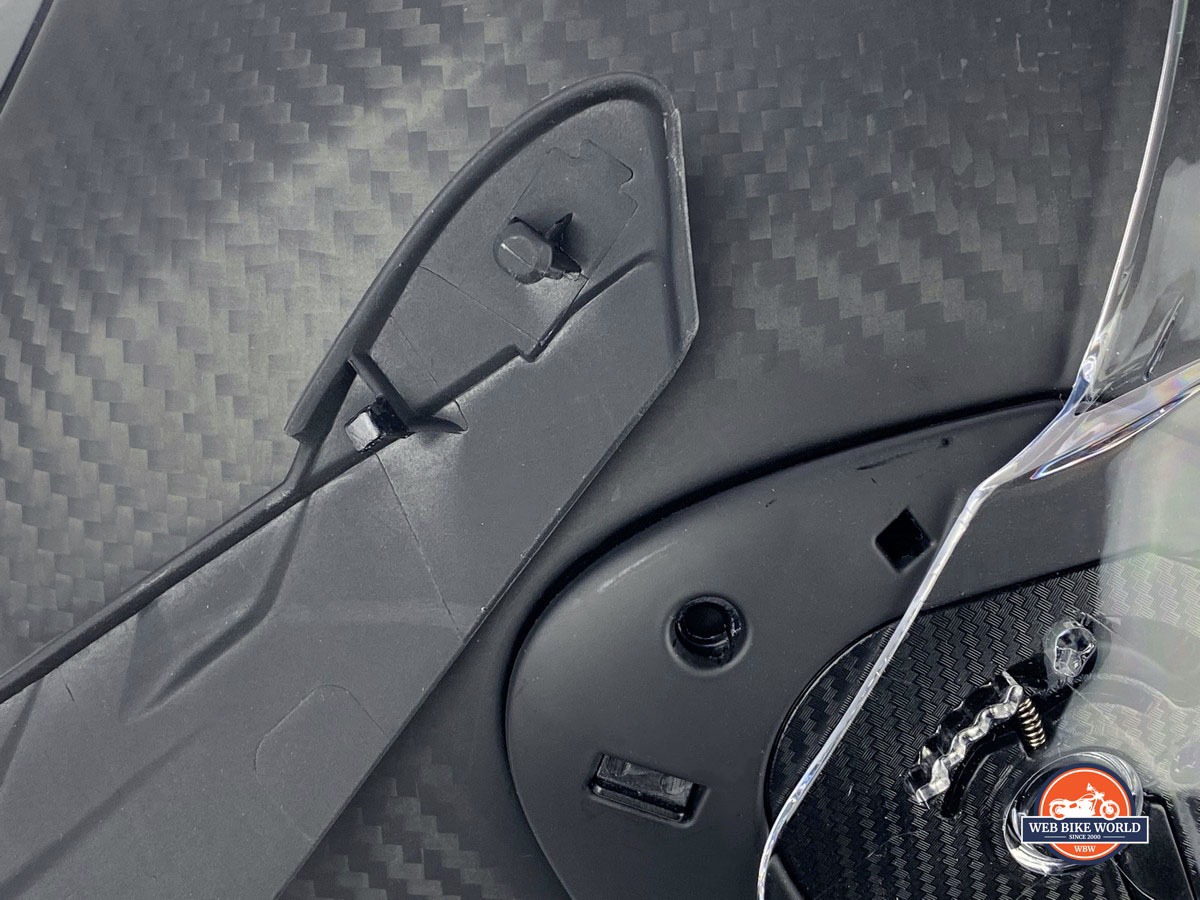
Visor Adjustments
There are 6 positions possible for the main visor including fully closed and fully open. Most important and worthy of praise is the fact this helmet has the “barely cracked open” position designed to help with fogging during cold weather riding, or provide a little extra ventilation when it’s hot out.
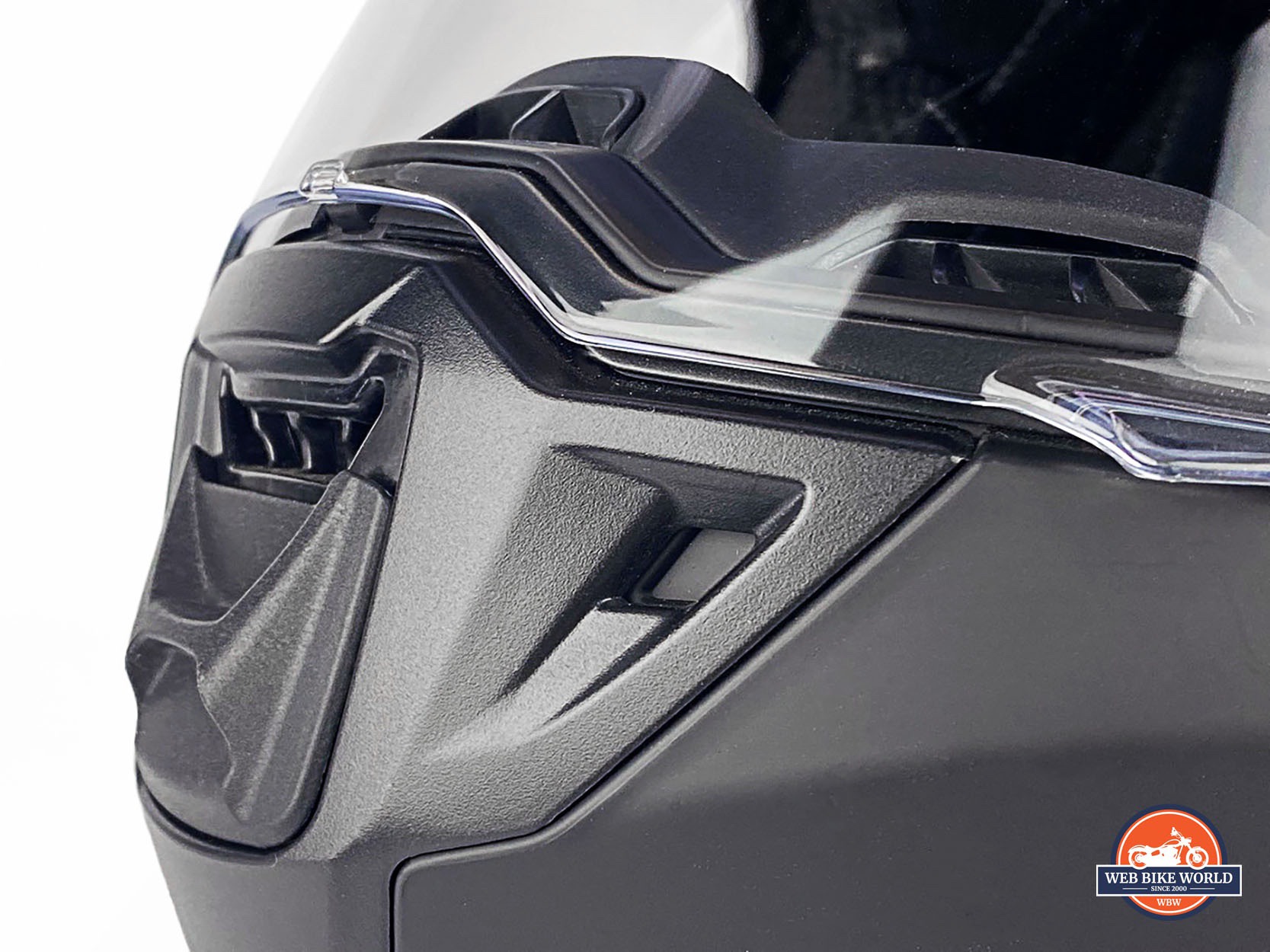
The visor action is smooth and when it travels through the detents, there isn’t a booming succession of thuds or pops produced inside the helmet to torture the wearer. It’s among the quieter visors I’ve experienced during my helmet testing career.
I also appreciate the ambidextrous nature of the main visor, thanks to large tabs jutting out from either side to help the wearer open it.
Integrated Sun Visor
I’m not a fan of the drop-down sun visor lens in the Quest. I think that’s due largely to the unnecessarily large notch carved into the nose area.
I know some people need accommodations for king-sized schnozes, but the massive “Sea of Snortez” found in the center of the lens creates a distraction for me due to the contrast between the brightly lit cutout area and the tinted portions on either side. Quin should adjust the notch/gap to half the height or less than it is now, in my opinion.
The Slider Switch
The action on the slider switch to lower/raise the sun visor is smooth and easy to manipulate even when wearing motorcycle gloves. I didn’t have any jams, malfunctions, or failures of the mechanism during my testing.
The degree of tint on the sun lens is about average compared to other helmets I’ve worn. Wearers who ride in sandy areas that reflect sunlight will likely want a darker shade, but this one works well for the Canadian riding environment I tested it in.
Quin Quest Smart Helmet Ventilation
The ventilation in the Quest is another area where this helmet needs improvement, unfortunately.
The Upper Vents
When I test helmet ventilation I play a game of “is the vent open or closed?”
If I can’t note a major difference between the two states of being for a helmet vent then I dock points from the score. That’s the case with the upper vents on the Quest. The sad reality behind the reason the ventilation is poor on the upper vents is that the sun peak blocks air from getting in them.
Once the peak is removed, the Quest can finally be effective at cooling the top of my head, but this isn’t a good design if I can’t use all the helmet accessories together harmoniously.
The Chin Bar Vent
The chin bar vent is worse because its issues can’t be blamed on the sun peak. It flows plenty of air into the helmet, but it directs 100% of it straight up into the visor instead of sending at least some at the wearer’s mouth and nose.
To make things worse, the flowing air that goes up into the visor bounces off it and lands precisely in both my eyes! This leads to dry eye irritation, rider fatigue, and a lot of teasing from my friends about my bloodshot red eyes whenever we stop for a water break. At least with the internal sun visor lowered, less incoming air gets past it to dry out my eyes (I guess).
The really unfortunate thing about both the upper and lower vents is that I like how snappy the sliding pieces are to actuate and locate with gloved hands. But they just don’t function the way they should in this crucial area of adventure helmet performance.
The Quin Quest Smart Helmet Out On the Road
My testing of this helmet spanned approximately 1500 miles ridden in temperatures ranging from a low of 0 Celsius (32 Fahrenheit) and a high of 25 Celsius (77 Fahrenheit). About 200 miles of that time was spent riding off-road.
It’s a comfortable helmet to wear in low or high temperatures despite some less than perfect ventilation. Its modular design allows me to pop open the chinbar if I get too hot in slow city riding, or have a drink or snack without having to remove my helmet.
This is a huge draw for owning this style of helmet and precisely why Quin went that way as opposed to full face.
Road Noise
The Quest is quieter at highway speeds than many other modular helmets are. It’s much quieter than the AGV Sportmodular Carbon, but noisier than the Touratech Aventuro Traveller Carbon.
I find carbon fiber helmets to be louder than fiberglass or composite shell helmets on average, but the last few I’ve tested have been much improved. I’m not sure how much longer I’ll be able to confidently say carbon fiber helmets are noisier if this trend continues, which is great news!
Please note that when I test helmets for noise levels, I do it while standing on the footpegs of my bike so that I can have my head in the undisturbed incoming airstream. I do this because the motorcycle fairing, mirrors, and other parts create turbulence and affect my perception of how loud the helmet is.
Rain Riding
It’s not often I can say that I got to test a helmet over three full days of heavy rain riding, but that is the case with the Quest. I attended a rally in Vernon, British Columbia in September 2021 called The Adventure Bike Gathering. It was a ton of fun other than the constant precipitation and cooler temperatures over the weekend it spanned.
To its credit, the visor seal on the Quest didn’t leak a whole lot, which is more than I can say for some helmets I’ve tested. 99% of the helmets I rain-test do leak eventually, so I don’t deduct too many points when it happens now.
Fogging Issues
Some helmets come with a Pinlock anti-fogging shield from the manufacturer while others don’t. My Quest didn’t include one nor is the visor even Pinlock ready, but luckily the newer Quest visors are ready for a Pinlock 70 lens that they’ll sell you for $30 extra.
I would STRONGLY encourage everyone to add that Pinlock to their Quest purchase because without it, riding in the rain can be downright dangerous due to the fogging issues I encountered. More than once I had to pull over and clean my visor to continue riding.
With the visor cracked open slightly I was able to keep the fogging to tolerable levels in cold weather, but once the rain started it was beyond irritating. I think Quin would be well-served to include the Pinlock in the $720 price tag of the helmet.
Lift & Pull
When I first saw the compact and aerodynamic-looking sun peak on the Quest I suspected it would be much more pleasant to wear on the highway than some other adventure helmets I’ve tested. I was right about that.
The peak doesn’t grab in crosswinds that always threaten to wrench my neck, and the overall smooth shell shape of the Quest doesn’t encourage lift or pull whatsoever. Bravo!
The problem with the compactness of the sun peak is that it can’t serve any useful purpose when it comes to blocking bright sunlight if you’re riding off-road in dusty conditions. If Quin wants this to be a bona fide adventure helmet, they need to increase the size of the peak or let everyone know it’s included purely for aesthetic reasons.
The BMW GS Pure helmet I tested earlier this year has the smallest sized peak on it that I find can still be useful.
Off-Road Riding
I wish it was just the sun peak holding the Quest back from its—ahem—quest to be an adventure helmet, but there’s more.
Heavy dust and fine powder sand is something any serious rider will encounter off-road, and I found after a few days of riding in it that the chin bar latches stopped wanting to do their job.
To ensure the chin bar latched fully I had to spray them with penetrating oil to free up the mechanism. A solid set of locks is crucial in a modular helmet because without fully securing the chin bar to the locking posts on the main shell, the wearer is effectively only wearing an open face helmet in a crash.
~35% of impacts in a crash land on the chin bar area, according to data I’ve seen. This highlights one of the possible drawbacks of choosing a modular helmet over a full face.
Quin Quest Smart Helmet Bluetooth Communicator Integration
The electronics and smart technology hardware is all perfectly integrated into the Quin Quest, and I give their designers full credit for that. The wearer doesn’t even know it’s there, thanks to how hidden everything is.
In particular, I love the way the microphone is hidden inside the left cheek pad but still functions well at picking up my voice during phone calls.
Also, the charging port/connector is conveniently attached to the end of a 4” long harness that cleverly pulls out of its hiding spot at the back of the helmet crown liner. That keeps it safe from harm and makes it much easier to plug in a micro USB cable, compared to the ports that are built into Sena/Cardo device housings, or integrated control boxes on Schuberth, Ruroc, Scorpion, BMW, and Shark helmets for example.
Got Intercom?
I was shocked to discover the high-tech electronics of the Quest don’t include a universal communicator function. Still more unbelievable is how It can’t even connect via intercom with other Quin helmets (from what I understand).
This is a basic feature of even the most basic Bluetooth devices on the market and a big missing option on something labeled a Smart Helmet.
Functionality
Having said that, the existing Quest electronics work well doing the things they’re designed to do—like making phone calls and playing music. I never experienced a loss of connectivity to my iPhone while using it, but I found it didn’t get along well with the dash/display on my KTM 790 adventure. I had trouble getting those two to play nicely and gave up trying after a while.
Battery Life is outstanding on the Quest. Quin says it will handle 6 to 8 hrs of use before needing a charge, but I found It lasted 2 full 8 hour days of riding at one point during testing before I could charge it. I never did manage to kill it at any point (even while using it in cold temperatures) but did get a low battery warning once.
Sound Quality
I’ll be blunt when describing the speakers’ very ordinary sound quality. It’s not even close to the current premium levels available from Sena/Cardo and their friends at Harman Kardon/JBL.
The Quest speakers sound clear but tinny and hollow. They get distorted when music is played at (or just below) full volume, too. To hear anything well at highway speeds, the volume needs to be up near the maximum level.
I think the non-adjustable speakers are mounted too far away from the wearer’s ears, which is almost always a cause of audio issues. I would rate the Quest as having the same sound quality as the original Sena 20S or 30K speakers. It’s not terrible if you don’t know any better, but if you do know what you’re missing, these will leave you wanting.
The Controls
The small buttons on the left side control panel are unpleasant for me to use while wearing any kind of gloves. They’re just too small in size to be useful, period. I end up stabbing blindly at where I think the desired button should be and hope for the best because I can’t quickly or accurately identify these bumps using my fingers.
Adding a voice command function equal to the standards of Cardo headsets would be a super useful improvement on the Quest.
I was able to activate Siri on my iPhone fairly consistently with this helmet if I could hold down the correct button long enough on the control panel to wake her.
The App
Quin could also expand the value of their app by programming it to control the audio, phone calls, etc. Currently, it doesn’t allow the user to do any of that, but that could easily be changed.
As it stands, the app works well for what little it is set up to do. I was able to enter my emergency contacts easily and activate the SOS beacon manually to send my location by text to them.
The accuracy of my location was at the Google Maps level and therefore should be good enough to have an ambulance rescue me in the event of a crash—but only if I crash somewhere there’s cellular service.
It’s Not Good Enough
Forgive me for asking what good an automatic distress beacon reliant on cell service does in an adventure helmet?
Adventure riding primarily happens outside cellular range, making the added cost of the SOS technology in the Quest mostly irrelevant for that class of motorcyclists. If the Quest had a built-in GPS/satellite automatic distress beacon like on SPOT or InReach devices, they’d have lightning in a bottle!
I think the Quest needs to become a quintessential helmet for adventure riding, and Quin has to find a way to do it for less cost to the consumer than if they buy a separate rescue beacon device.
One strategy would be to eliminate obsolescence by making the rescue device removable. That way, it could be transferred to the owner’s next Quin helmet they buy down the road, possibly further cutting the price tag down.
I acknowledge the usefulness of the Quest’s automatic SOS beacon while in cell range but will point out there are more than a few apps already available for cell phones which can detect crashes and automatically notify emergency contacts.
Even Apple watches can detect a fall or crash and dial 911 to send the wearer’s location directly to EMS now.
Quin Quest Smart Helmet Visibility
A common issue with helmets these days is low visibility. That can easily be remedied if manufacturers place bright colors, reflective stripes, piping, decals, or even LEDs on the shell to better get the attention of drivers surrounding the motorcyclist.
Quin hasn’t undertaken including any of those safety measures with the Quest design—but they should on future models.
Final Verdict: Quin Quest Smart Helmet
The Quest is a long way from perfection, but that’s no surprise—considering it’s the first generation of adventure helmets for Quin. They’ve accurately identified an important and yet-to-be-filled niche in the adventure helmet market, but have failed to produce the right helmet for the job.
The Quest is not terrible, but it’s not great either. It’s just ok. They’re going to have to keep polishing it over time to eventually make it the dreamy modular adventure helmet I wish it was.
Is the Quin Quest a Smart Helmet?
I think not.
When I hear the term “smart helmet”, what comes to mind is a high-tech model that does something extraordinary and goes beyond being feature-rich. We’ve already had helmets with fancy tech features built-in for years now.
A quality heads-up display would bump the Quest closer to entering the Smart category more than just a cellular-service-dependent SOS beacon does.
Cameras facing rearward or offering 360 degrees of vision with a collision warning system would solidify the claim, or incorporating some advanced safety warning system using a sophisticated phone app/onboard wizardry (as is found in the Forcite helmet). I think the Forcite MK1 is a smarter helmet than the Quest is from what I’ve seen thus far, although it’s also in its infancy.
True Smart Helmets are on their way to us, but they’re not here yet.
Dollars & Sense: Quin Quest Smart Helmet Value
Let’s assume the electronics on the Quest amount to be worth about $200 and subtract that from the $720 price tag. There are numerous excellent modular helmets out there in the $200 to $600 range from HJC, Scorpion, Klim, Shark, Bell, and others.
I’ve even seen the AGV Sportmodular Carbon on sale for $499 before. Not all of these qualify as adventure helmets or have carbon fiber shells, but let me call a spade a spade: the Quest doesn’t qualify as being decidedly “adventure” or “smart” based on its performance with me out in the wild.
It’s crazy to say, but I found the Ruroc Atlas 3.0 performed better for me while riding off-road than the Quest did—and it’s not advertised as an adventure helmet.
Anyone could easily buy an inexpensive and more capable/feature-rich Sena 5S for $150, stick it on their helmet of choice, and use a Detecht app on their phone to incorporate the auto SOS feature. Ditto for equivalent Cardo devices.
Sena even has a decent modular smart helmet of their own now in the Outrush—and the Impulse will be dropping in December 2021, which looks even better.
Keep Innovating, Quin
If the pandemic hadn’t interfered with my 2020 plans, I would have visited the Quin HQ in Dallas to get an in-depth understanding of their company vision and facilities there. I’d still like to do that if time permits in 2022 so I can better tell the tale of this ambitious American helmet company.
I sincerely wish them all the best and hope they take my criticism of the Quest in the constructive spirit in which it has been intended. Make the Quest better, and I’ll do a follow-up review on it—but for now, I won’t feel tempted to wear it again any time soon on my bike.
Pros
- The only Smart, modular, carbon fiber, adventure helmet currently on the market
- The fully integrated comms system
- SOS beacon with automatic crash detection feature
- Carbon Fiber exterior in 3 shell sizes
- Comfortable fit
- Reasonably quiet for a carbon fiber modular helmet
- Clear optics/Good eyeport peripheral visibility
- Micrometric chinstrap latch
- Dual (ECE 22.05/DOT) homologation
Cons
- No universal intercom or MESH function
- SOS beacon feature only works when there’s cellular service available
- Tinny/hollow-sounding audio quality is below current Sena/Cardo standards
- Buttons for helmet Smart controls are difficult to use while wearing gloves
- Ventilation directs air at the wearer’s eyes
- Available only directly from Quin
- Pinlock not included and visor fogs up badly in rain or cold
- Dropdown sun visor has a large nose notch
- Chin bar latches are negatively affected by dust and dirt
- Sun peak is too small to block any sunlight
- Sun peak needs to be removed before the visor can be
- Expensive and yet doesn’t feel premium
- Somewhat heavy for a carbon fiber helmet (3.9 lbs)
Specs
- Manufacturer: Strategic Sport Ltd. Dongguan for Quin
- Price when tested: $719 US
- Made in: China
- Sizes: (XS) 53cm – 54cm (S) 55cm – 56cm (M) 57cm – 58cm (L) 59cm – 60cm (XL) 61cm – 62cm (XXL) 63cm – 64cm (XXXL) 65cm – 66cm
- Colors: Matte carbon fiber grey only
- Safety Designations: ECE 22.05 and DOT FMVSS 218
- Review Date: December 5, 2021
Important Links
- Where to Buy: only available at quin.design.com

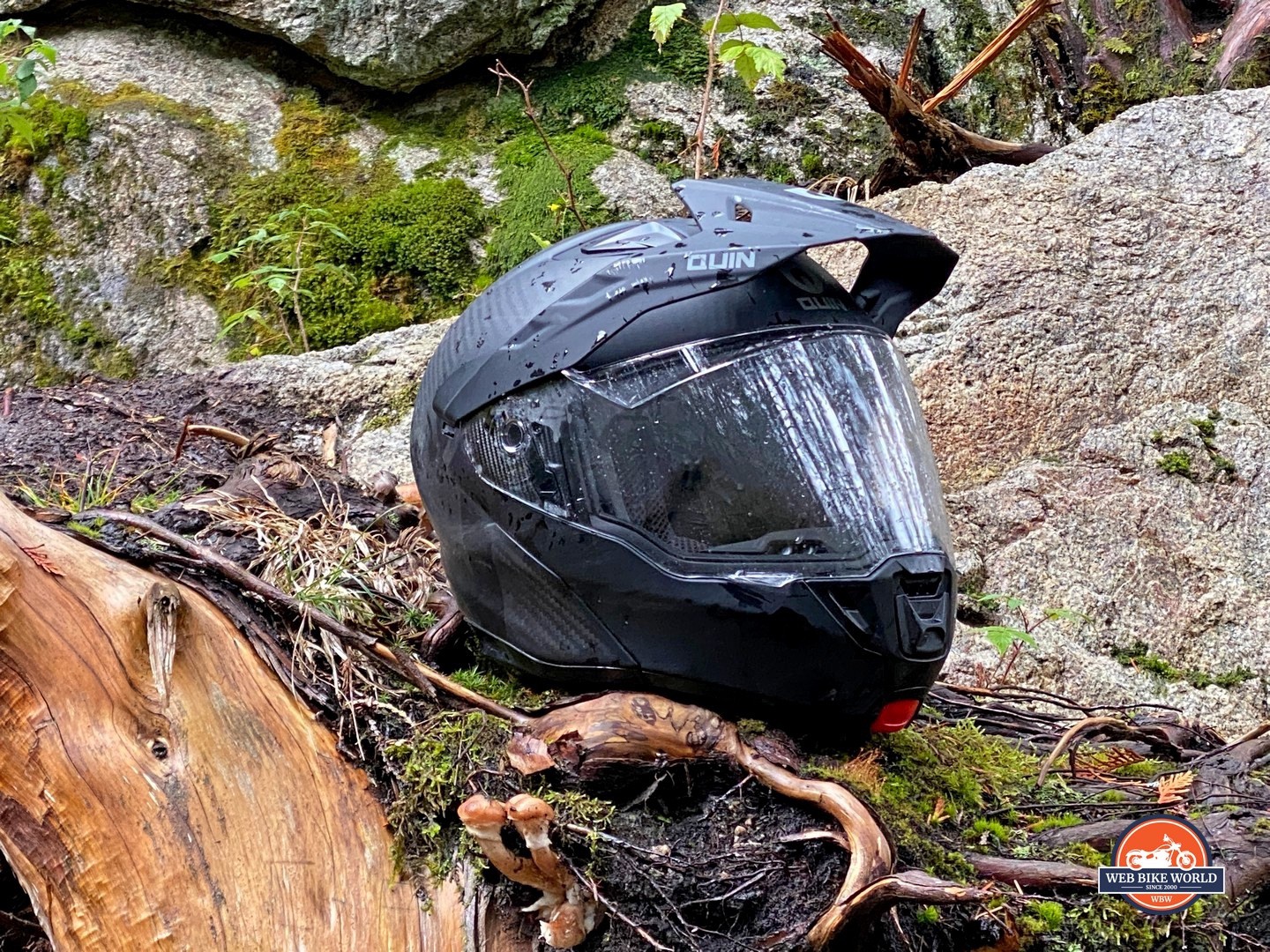
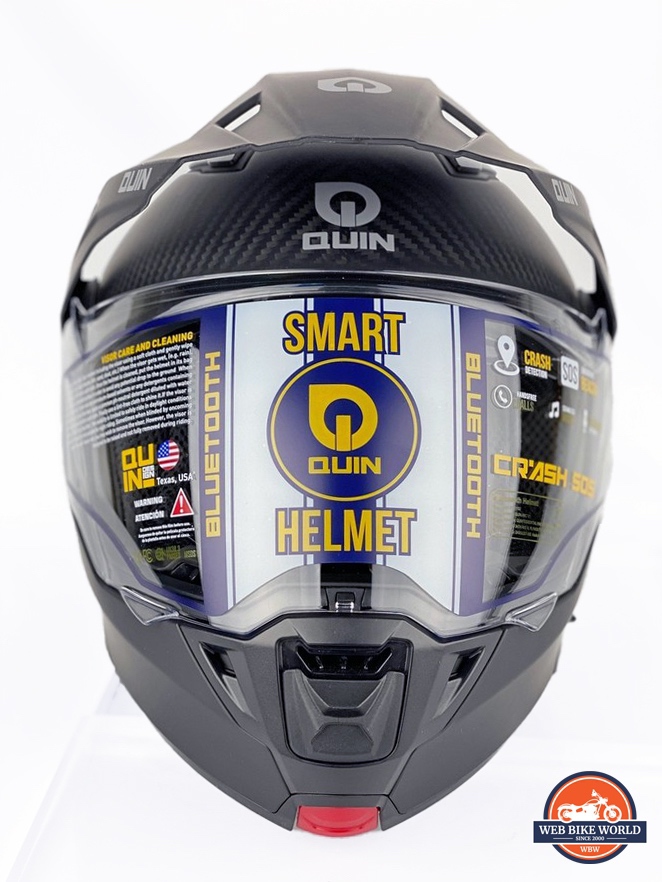
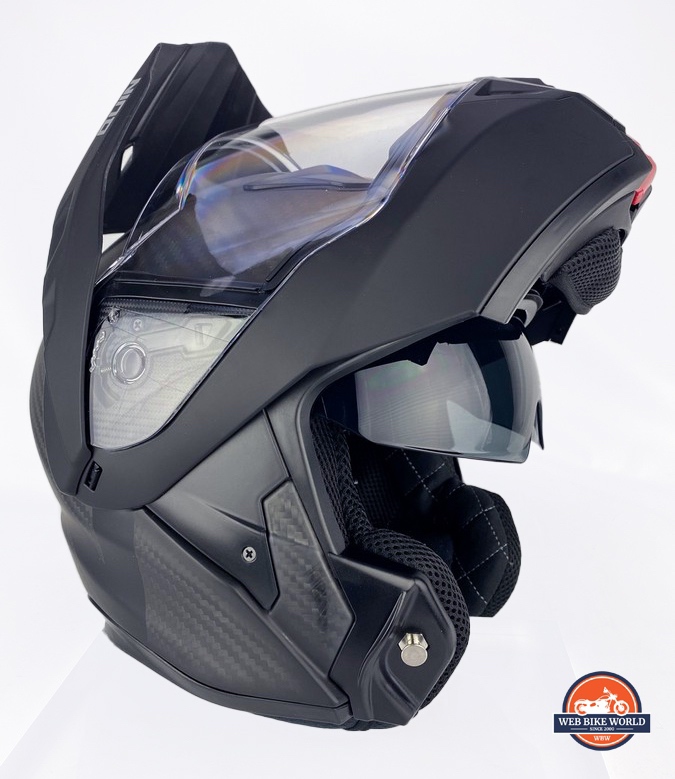
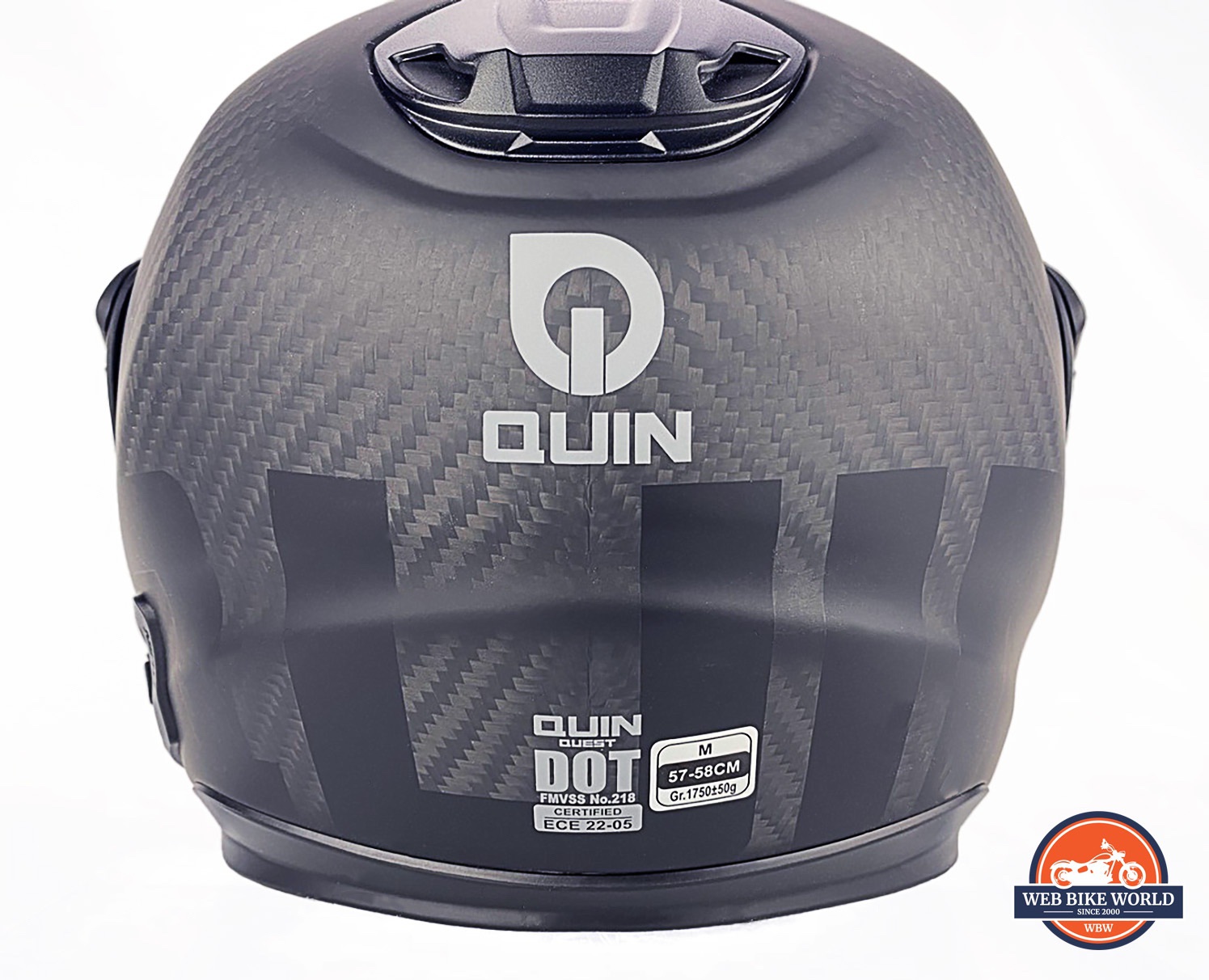
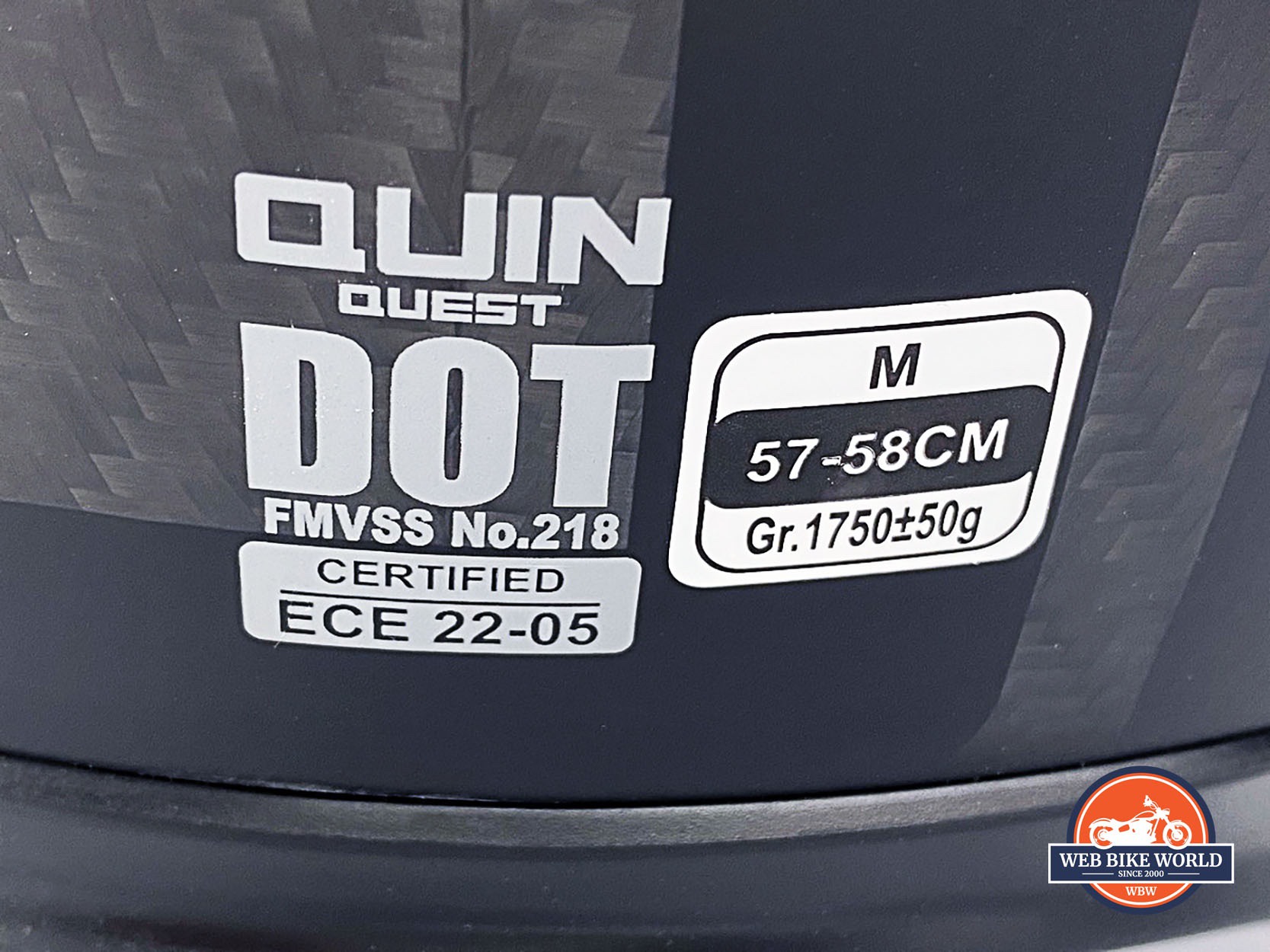
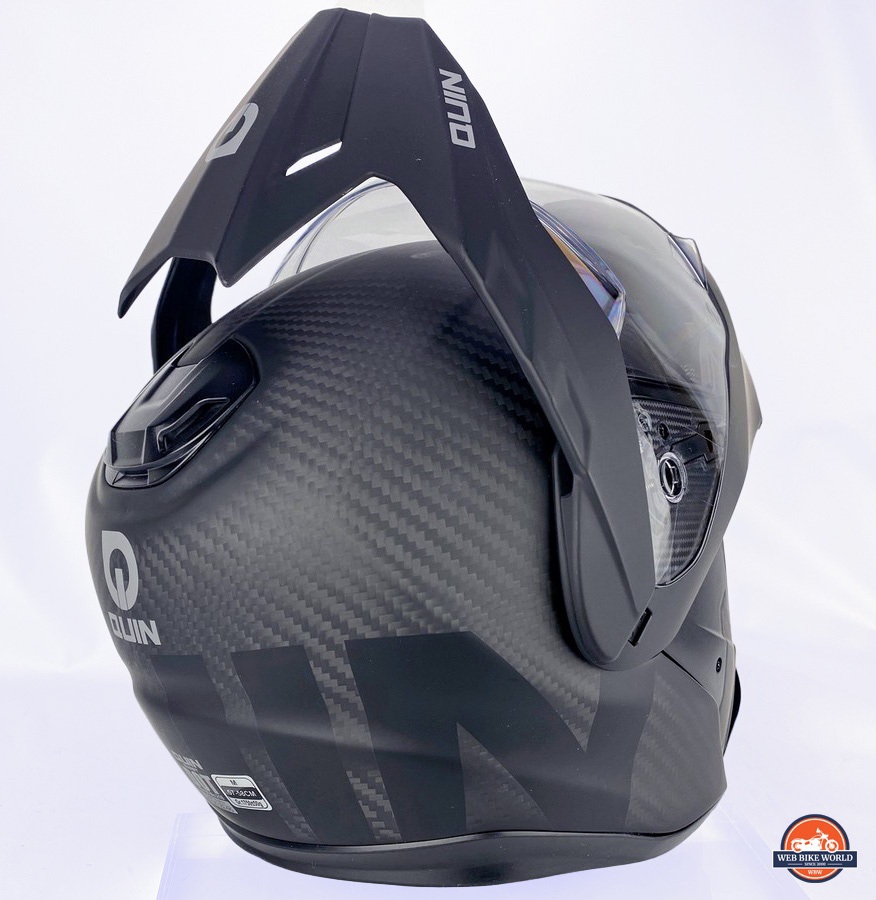

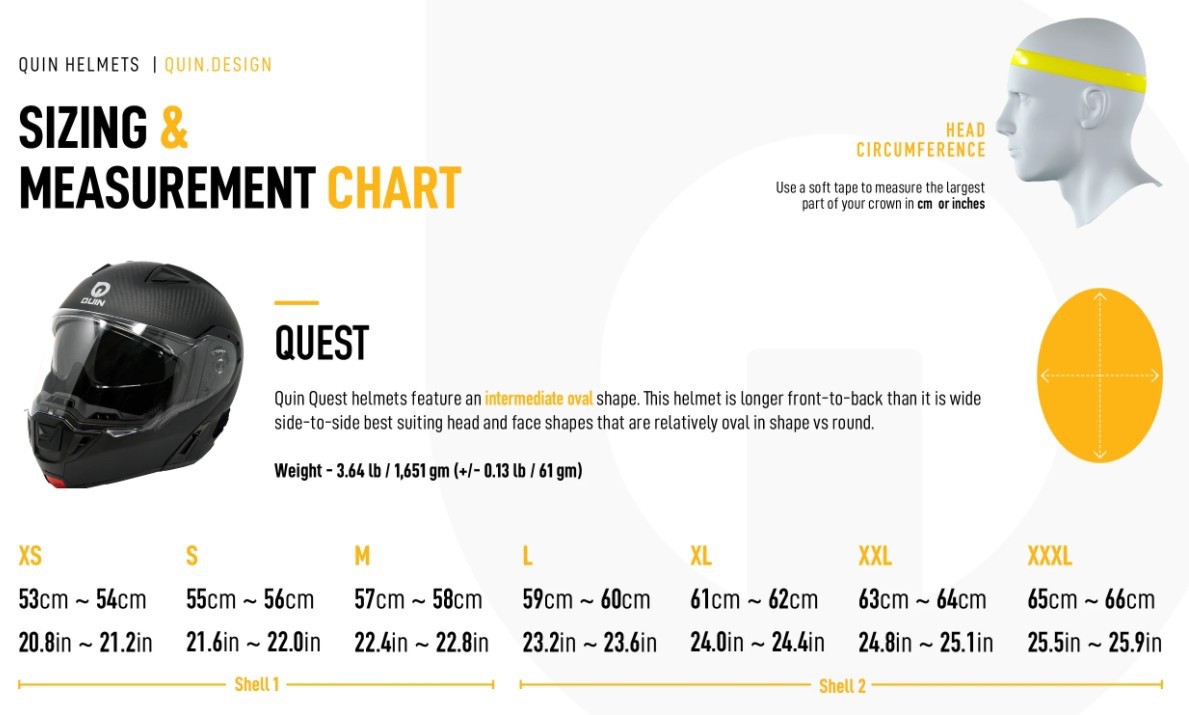
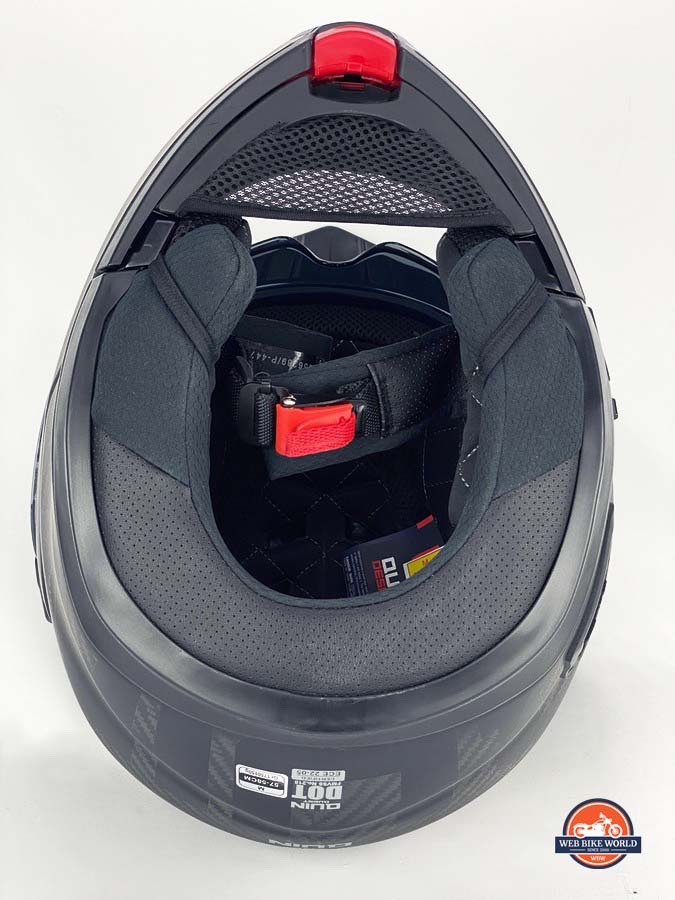

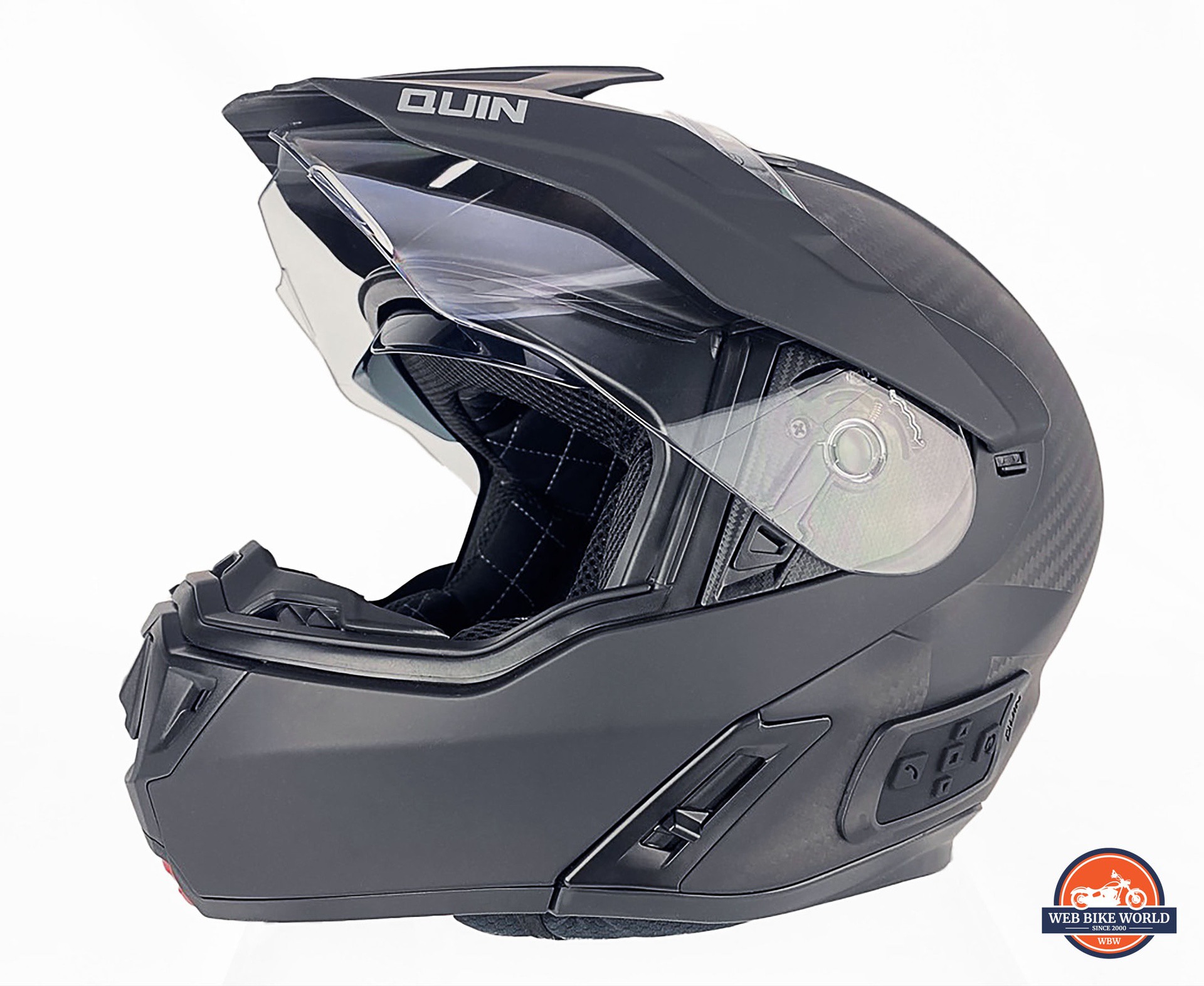
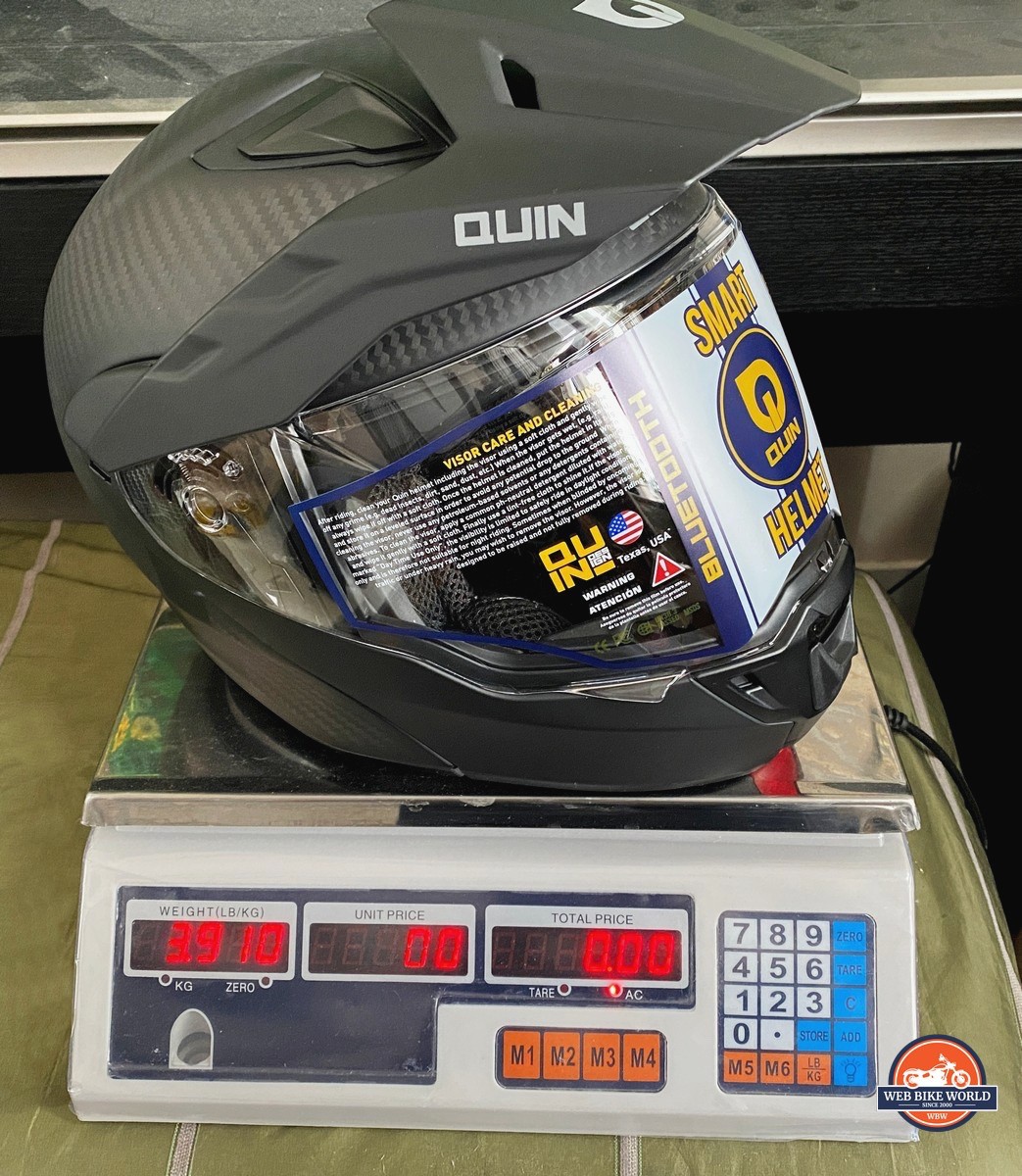
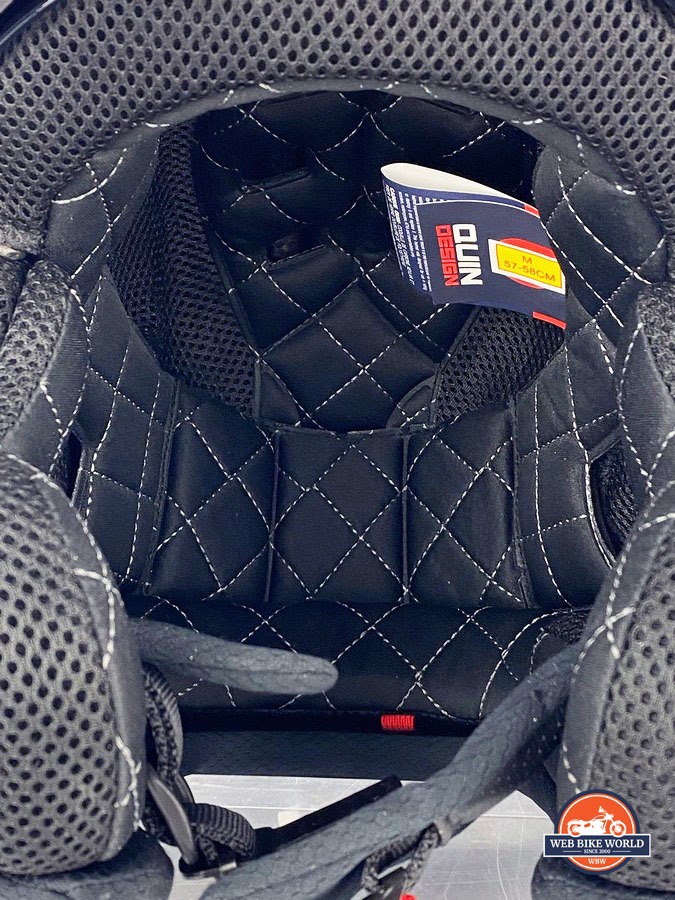
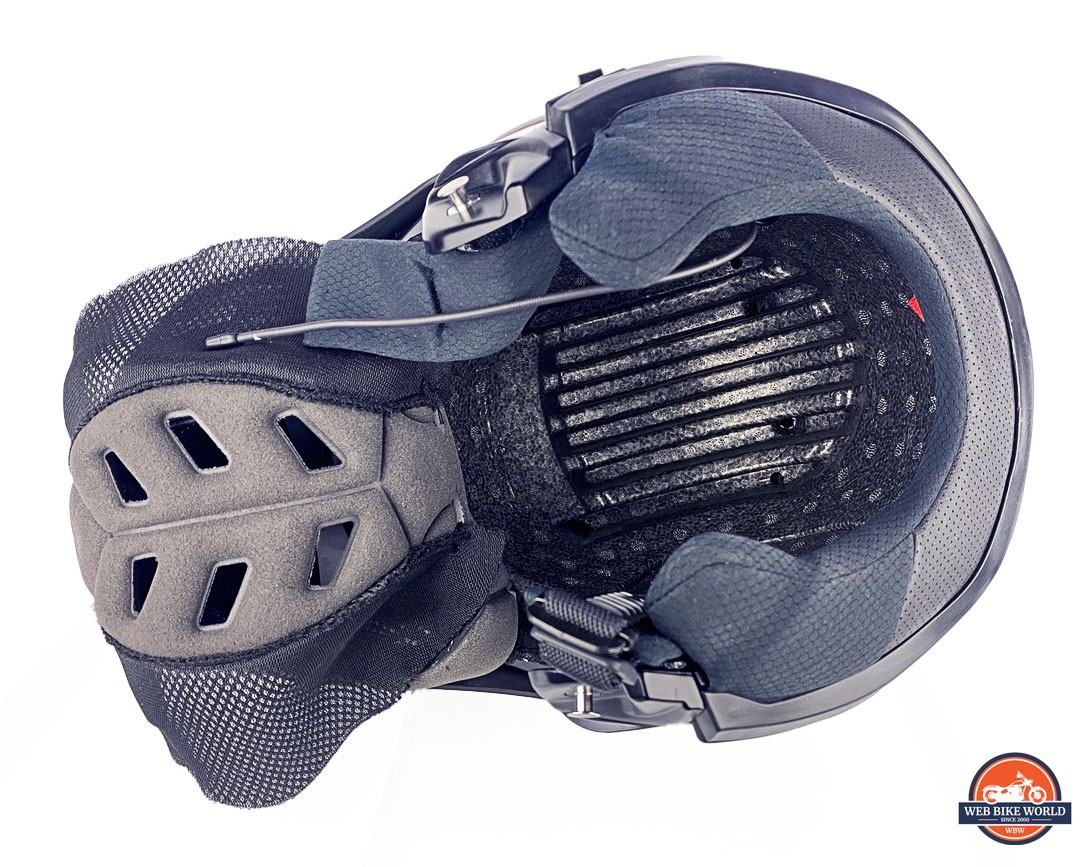
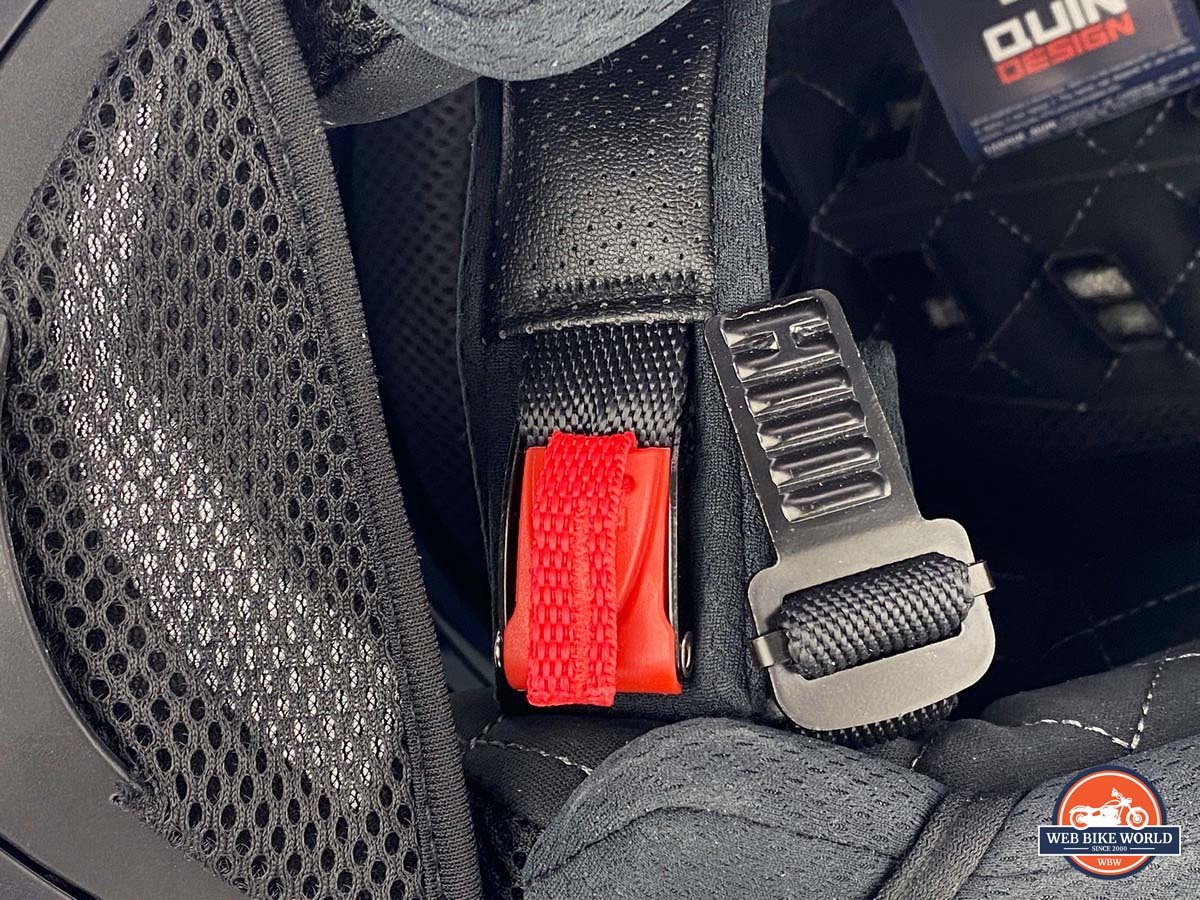
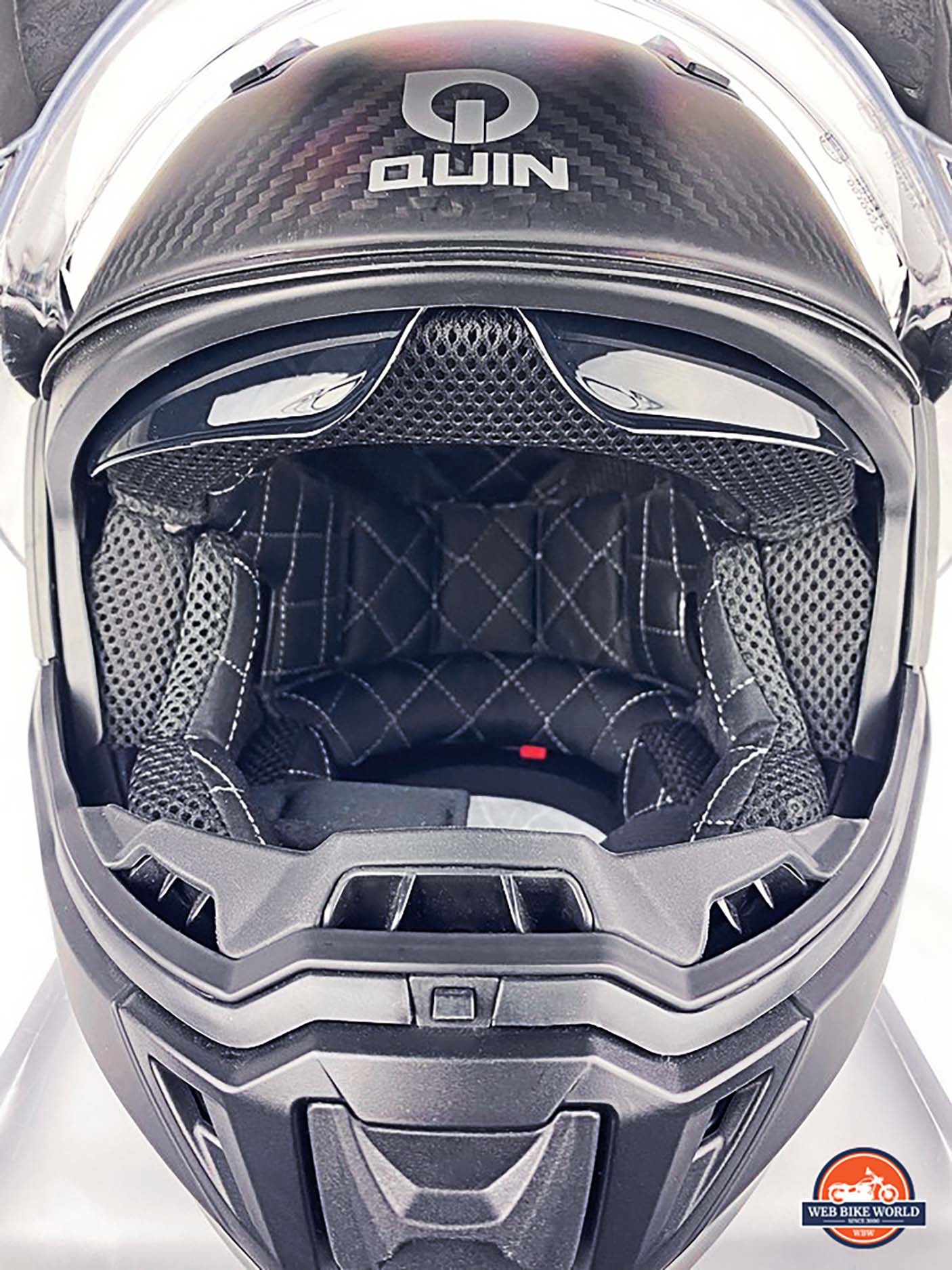
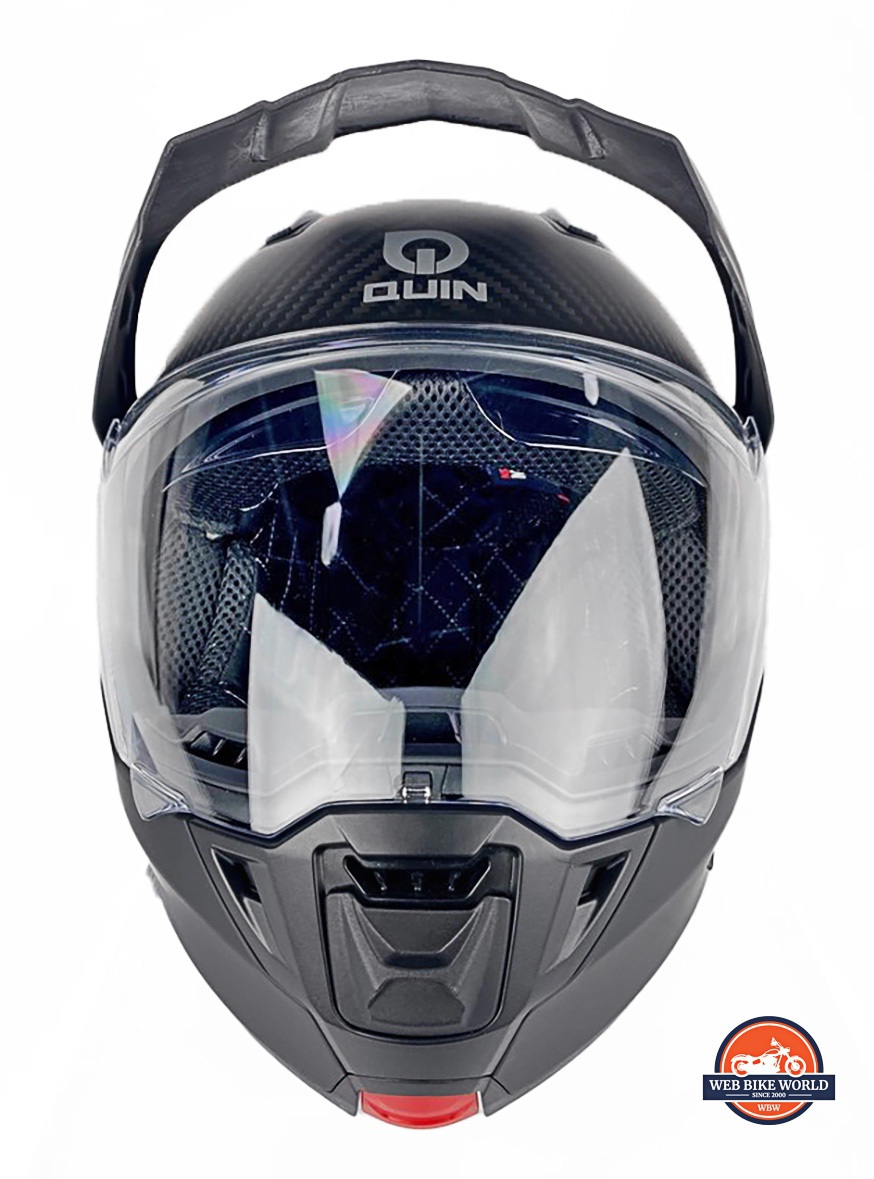
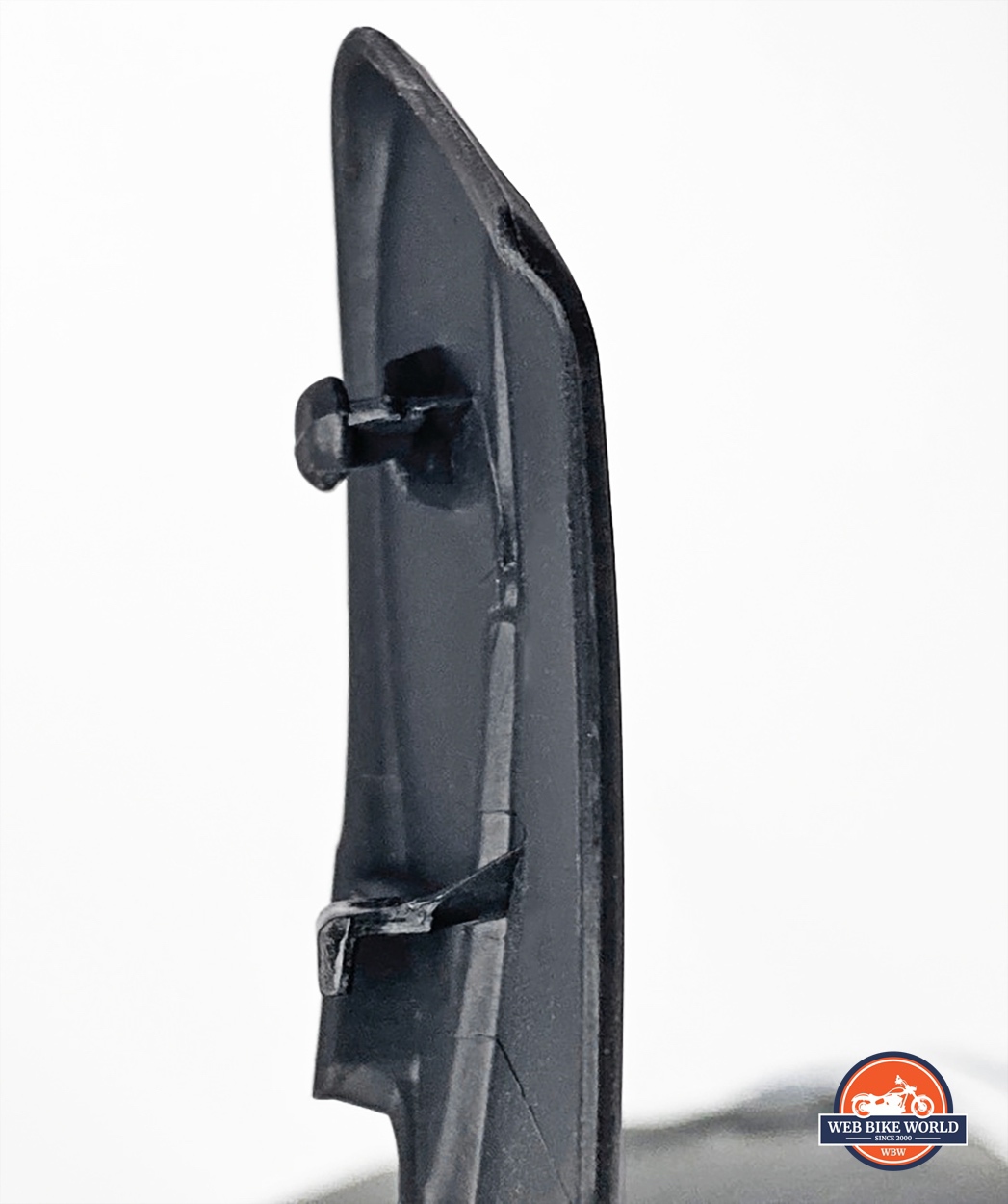
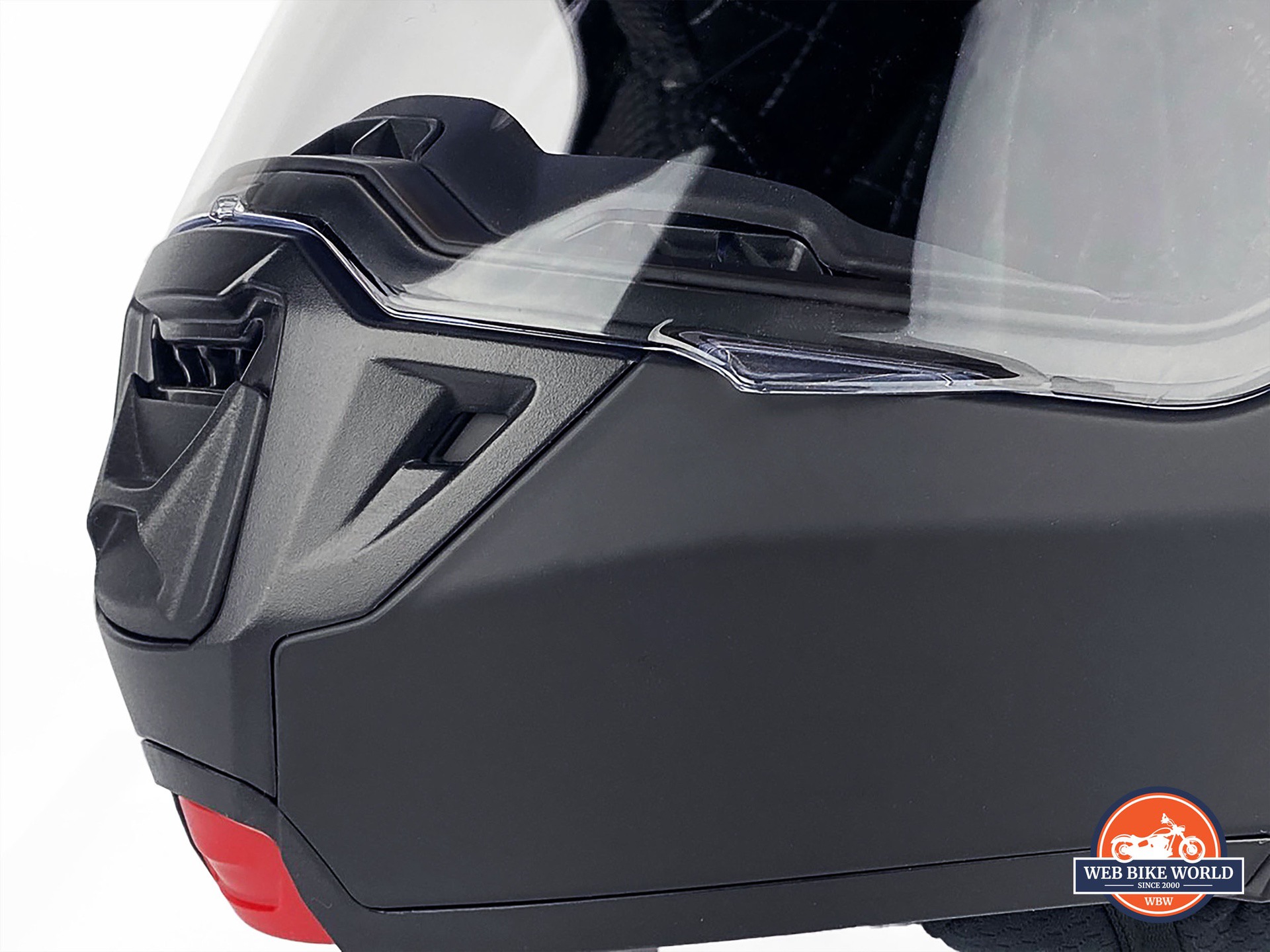
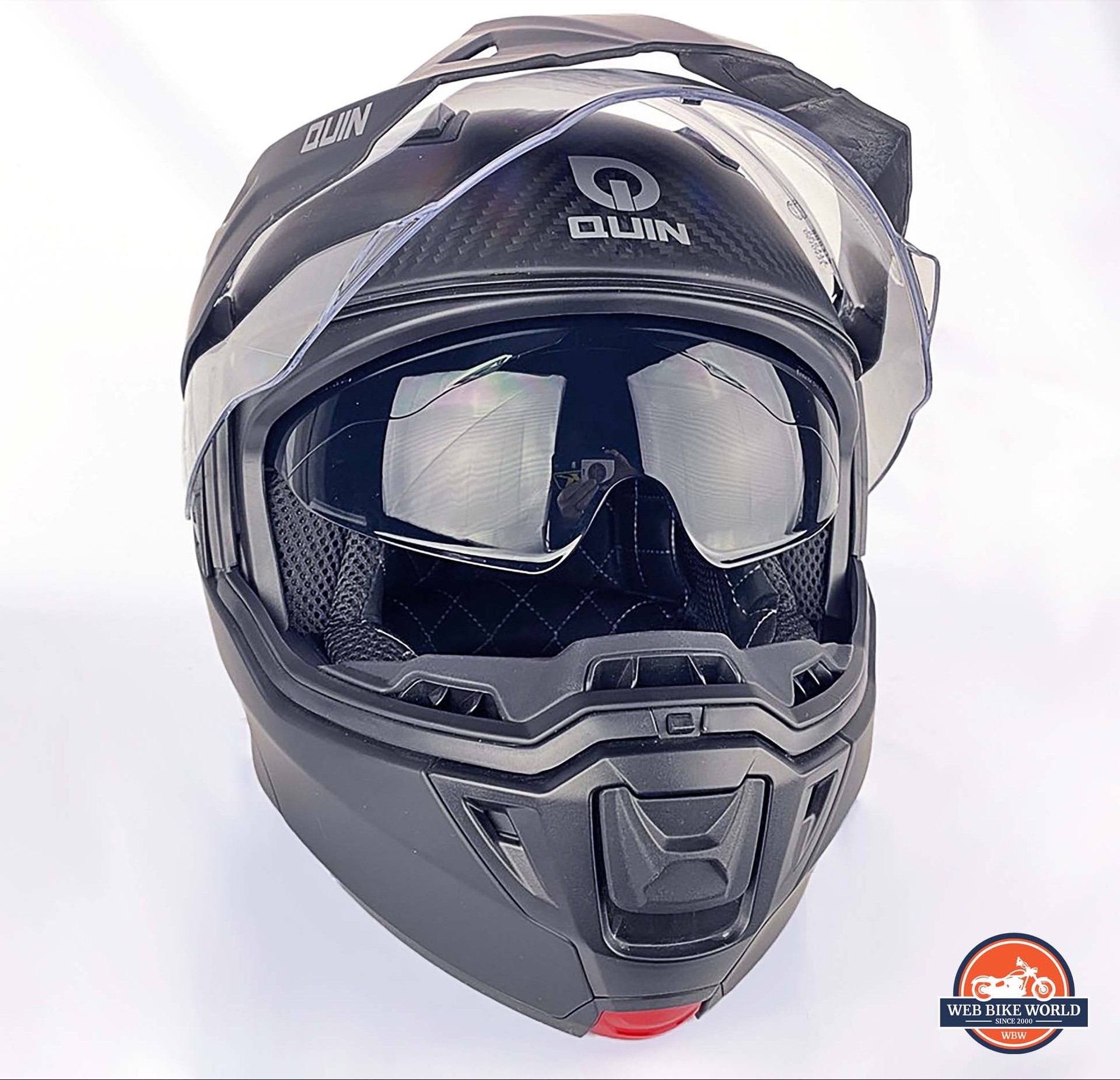
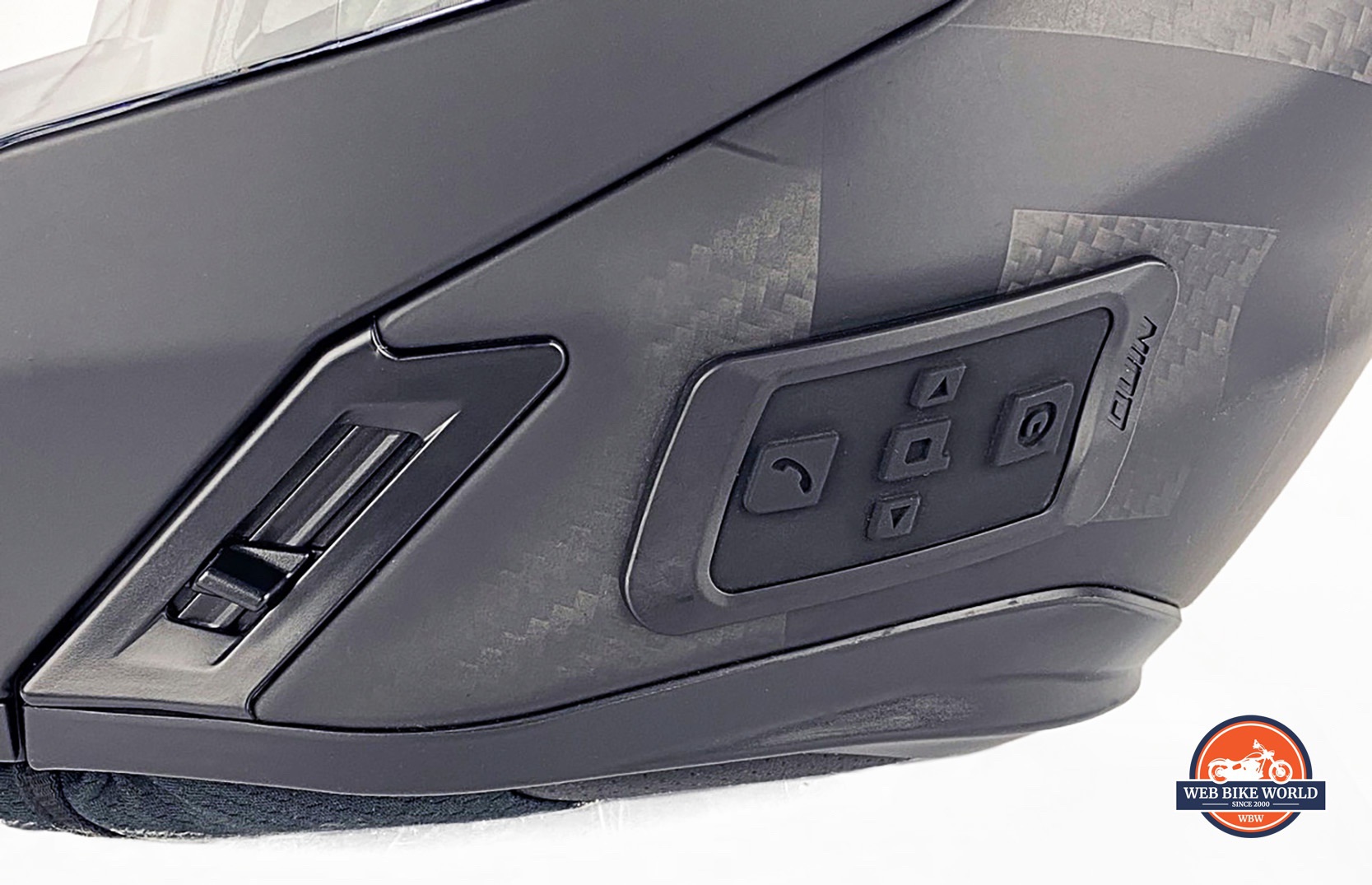
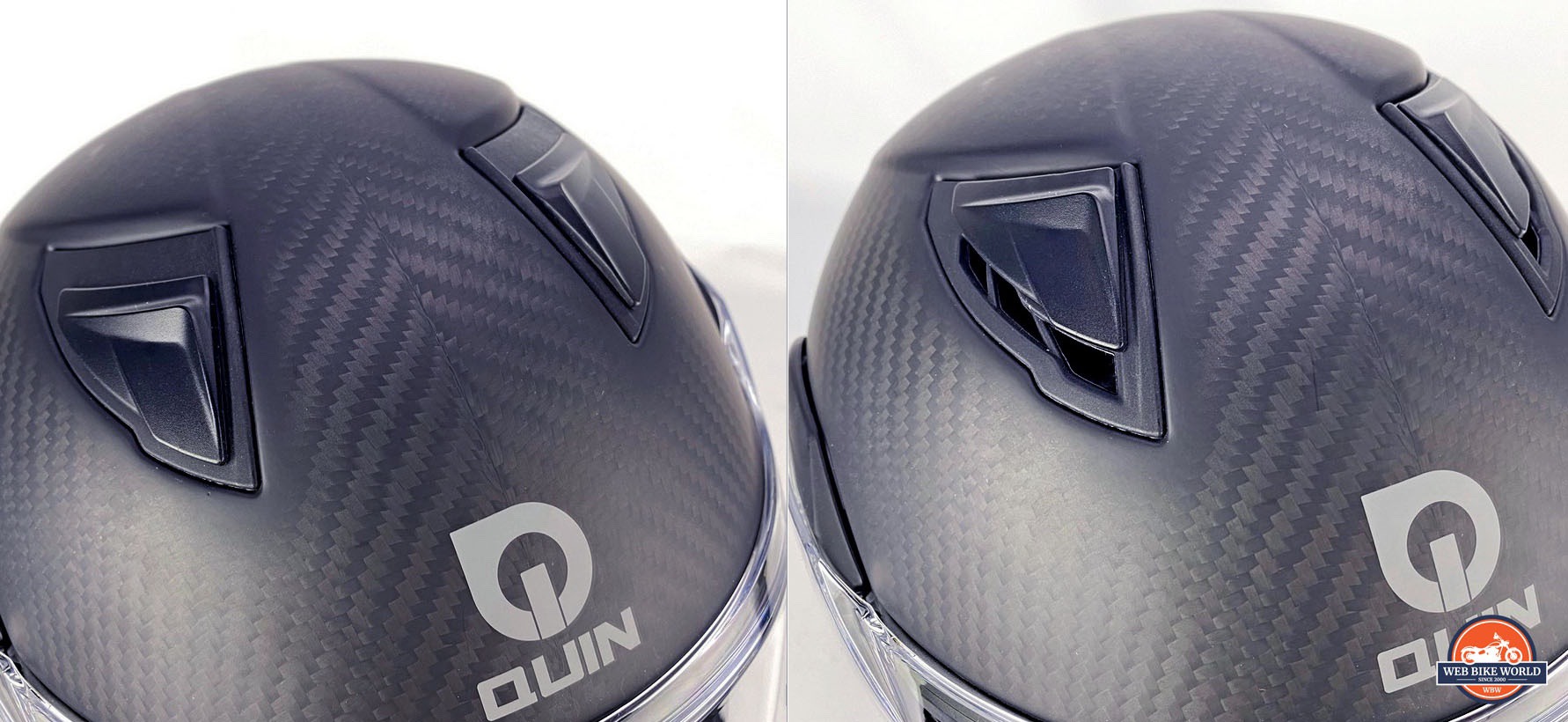
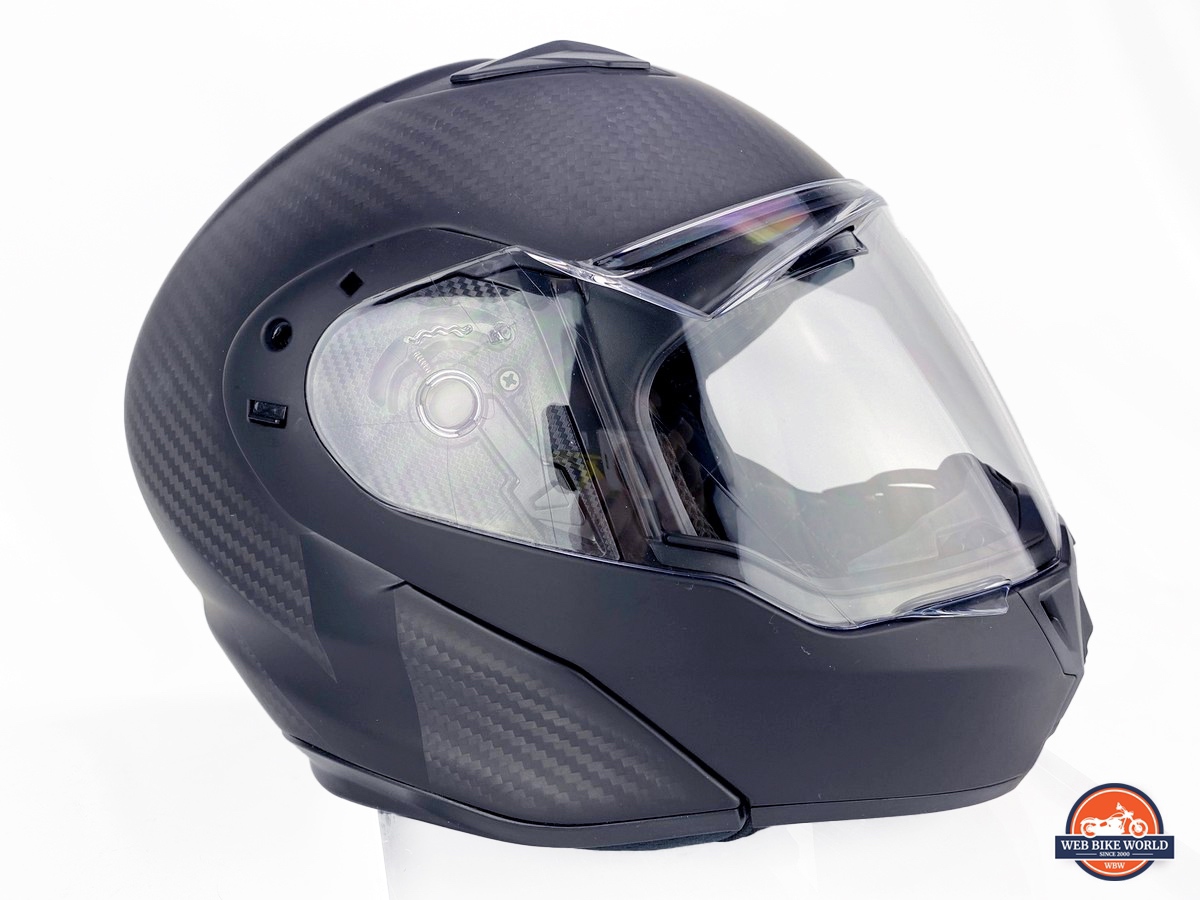
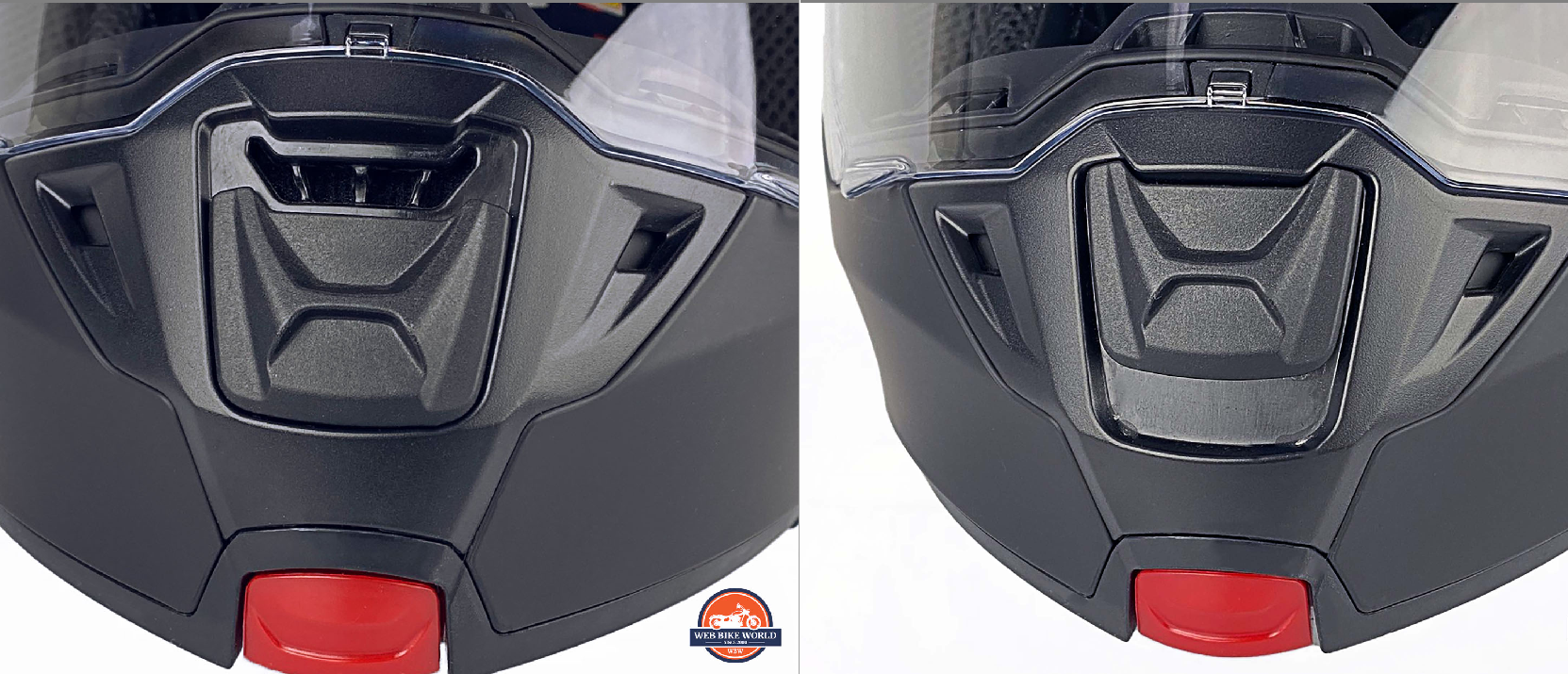
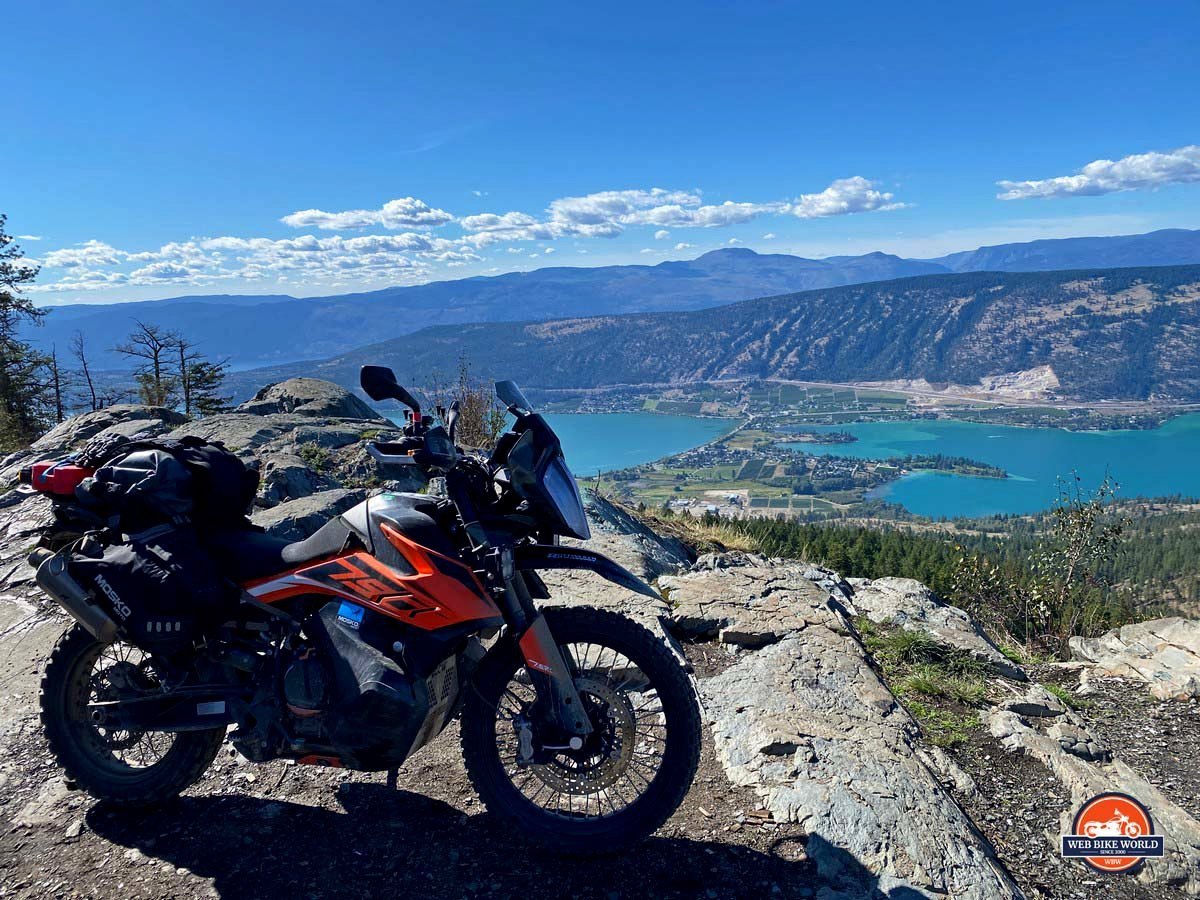

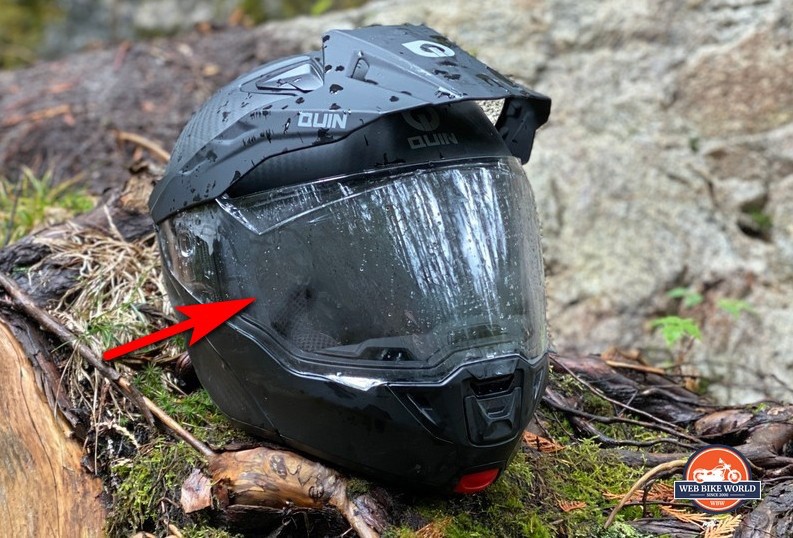
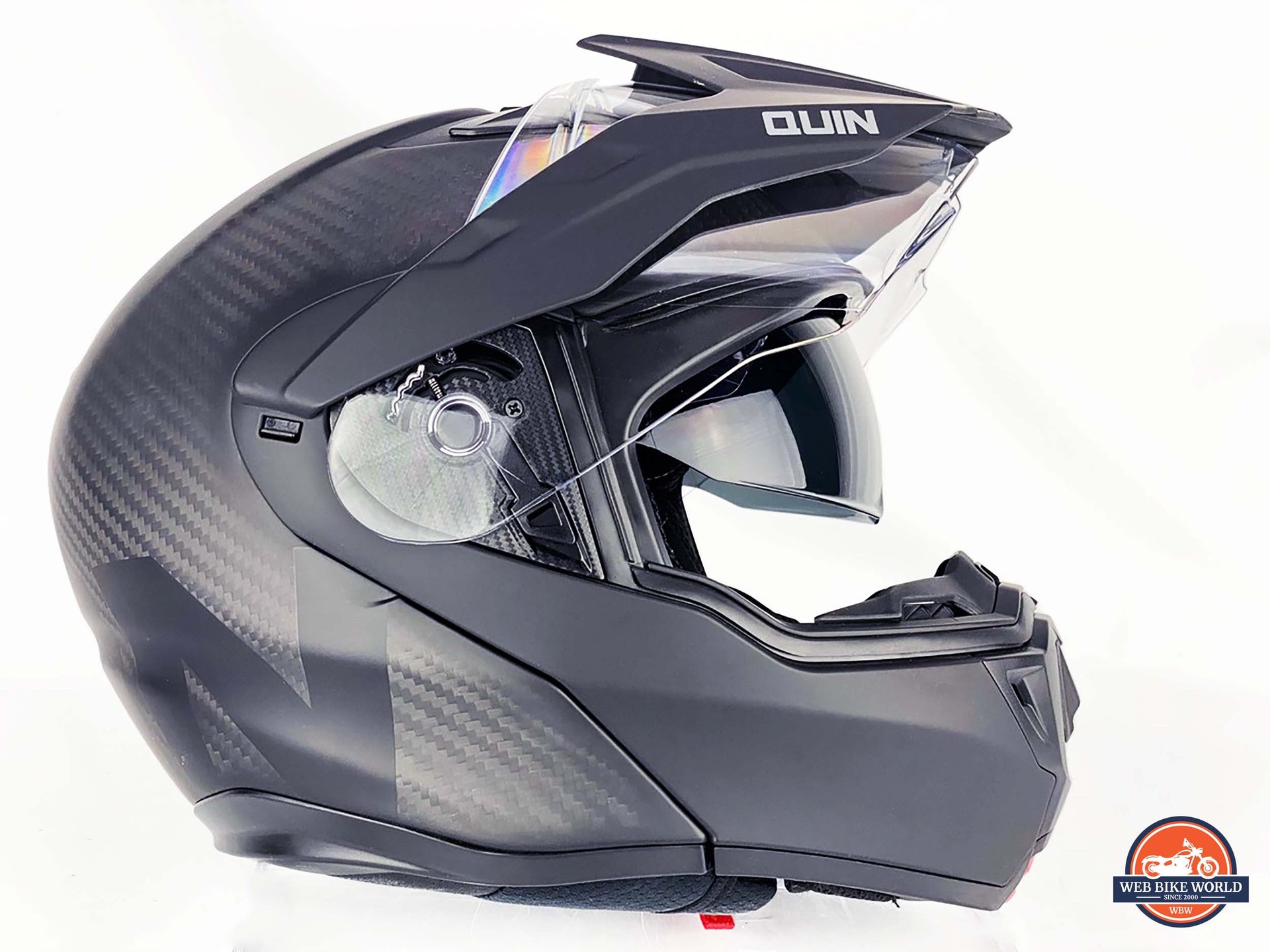
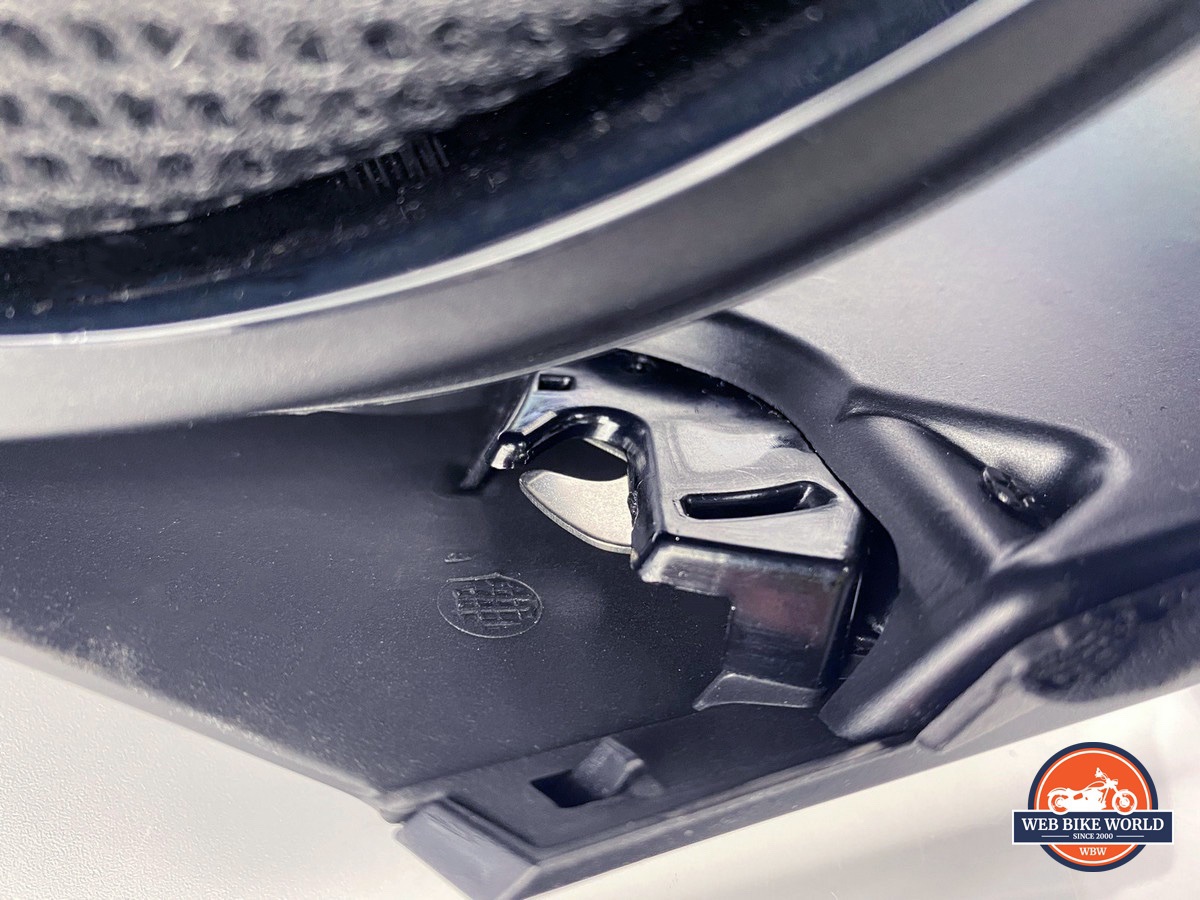
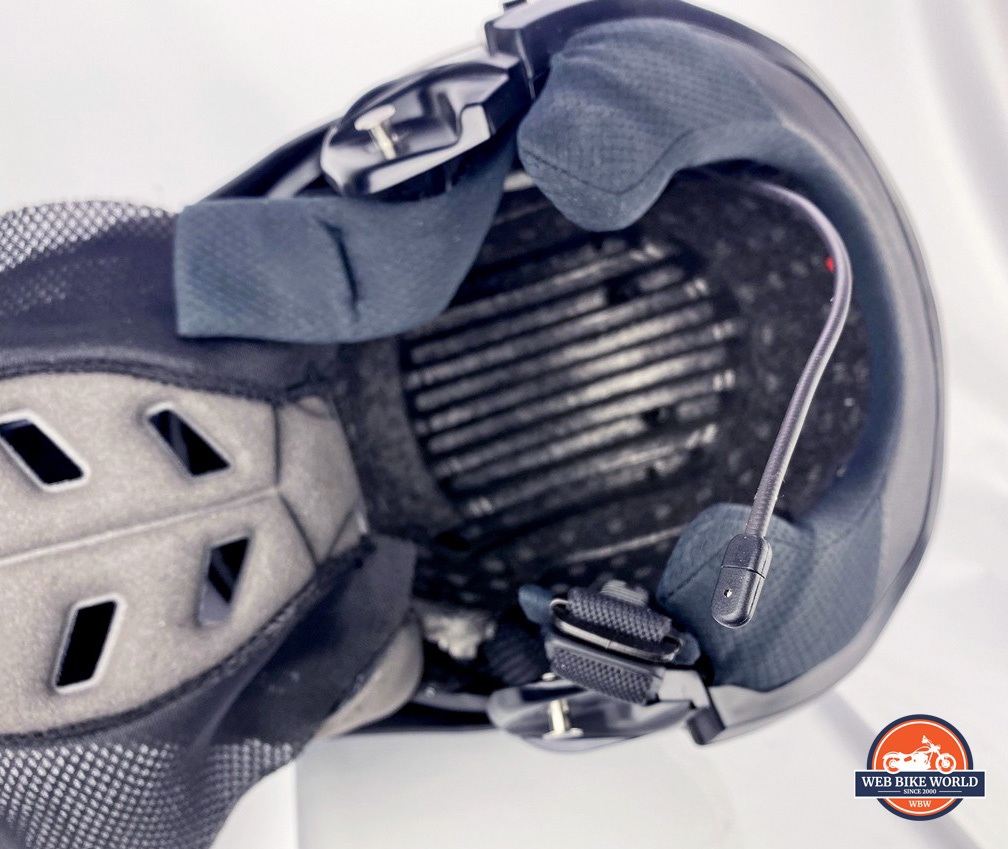
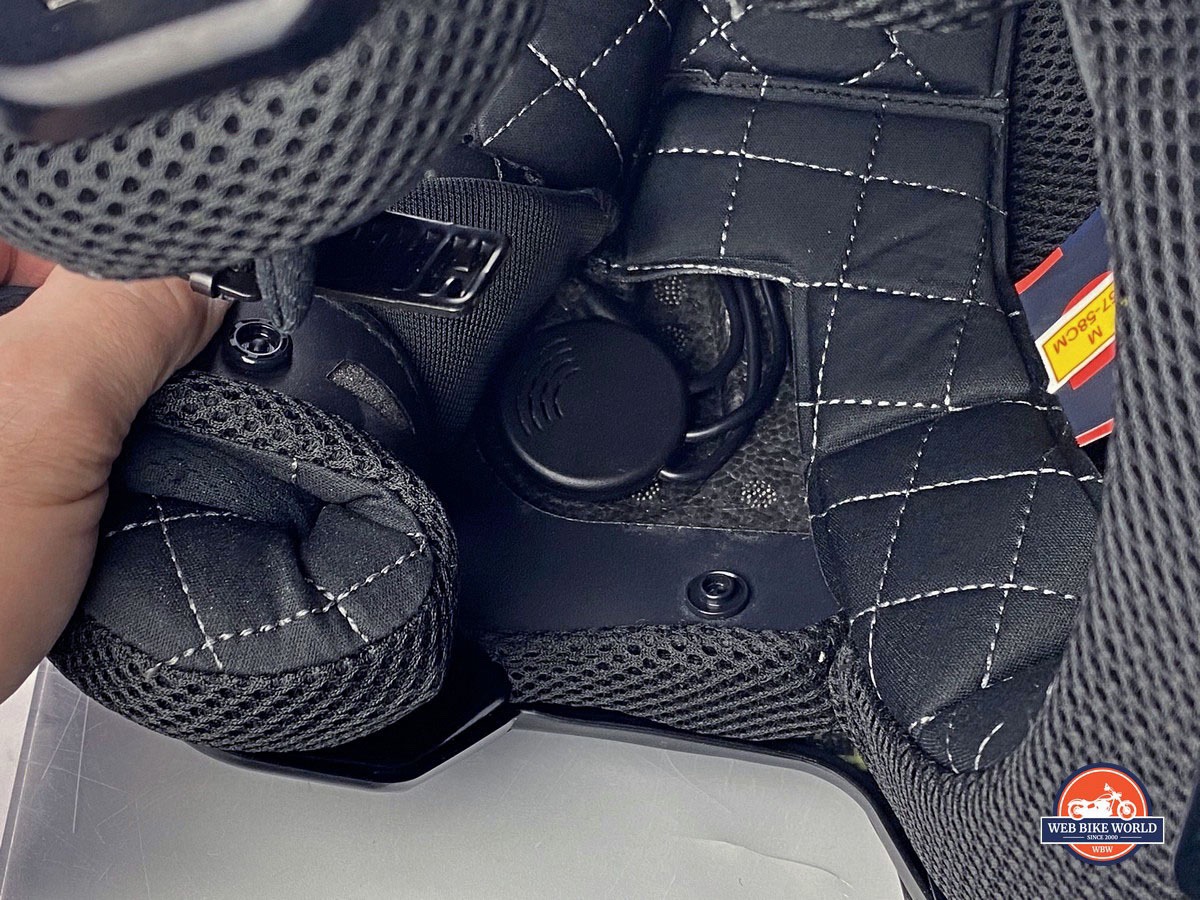
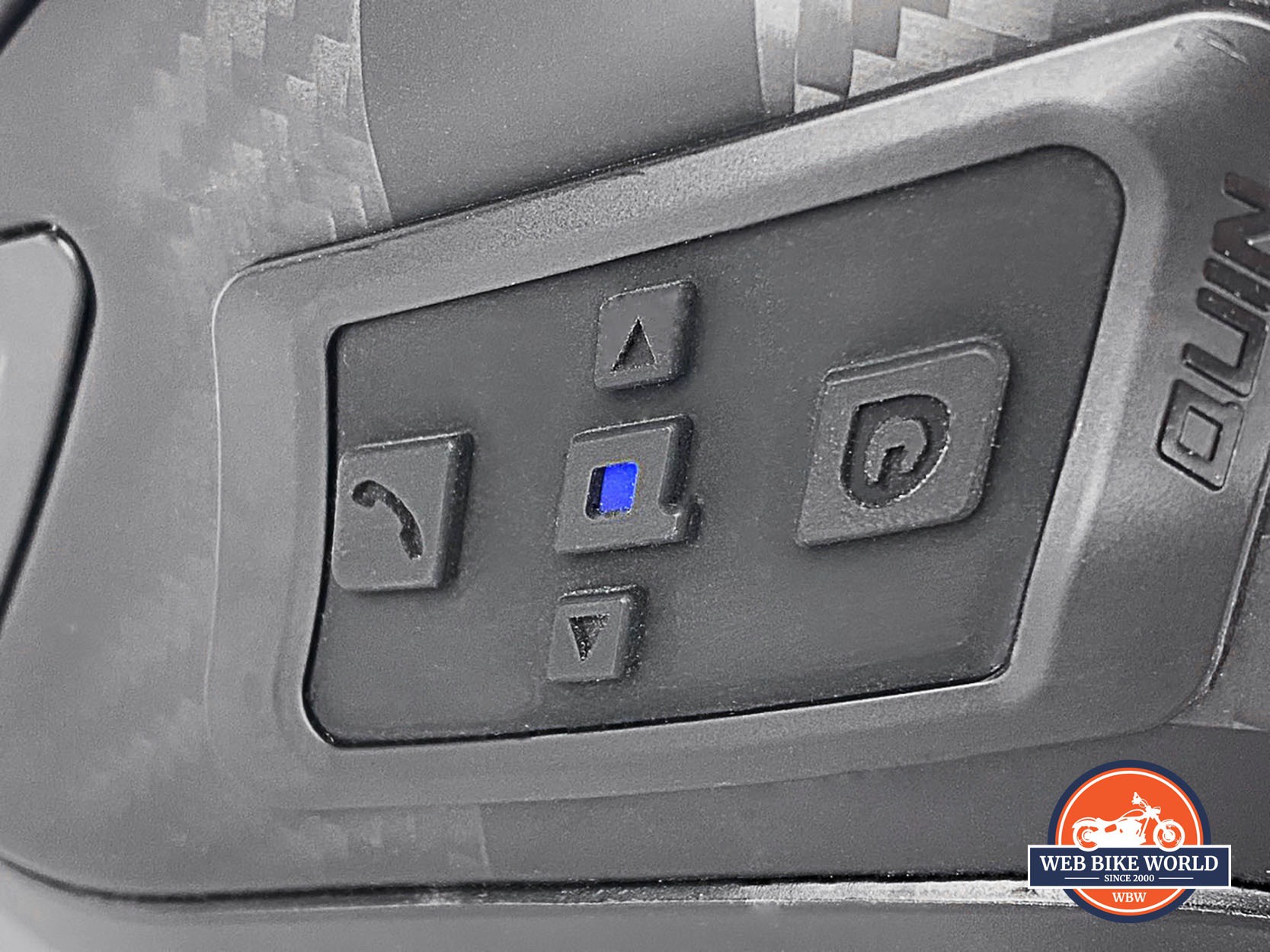
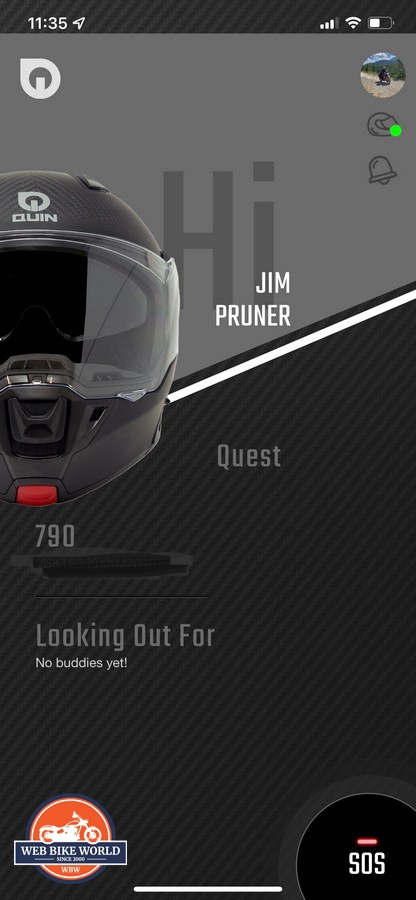

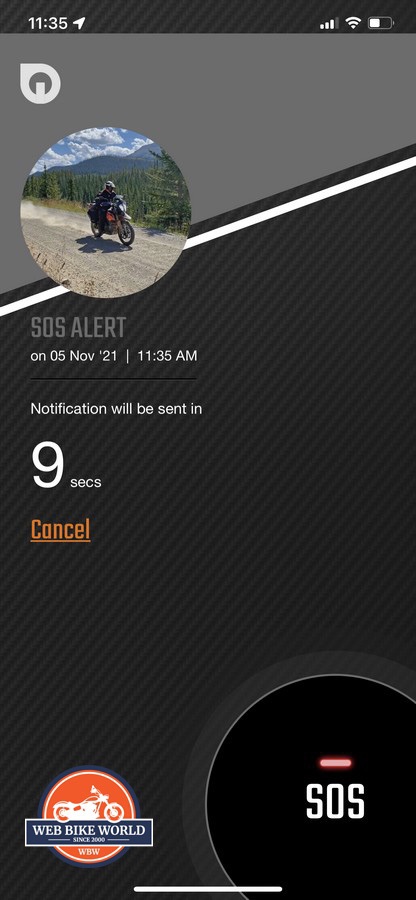
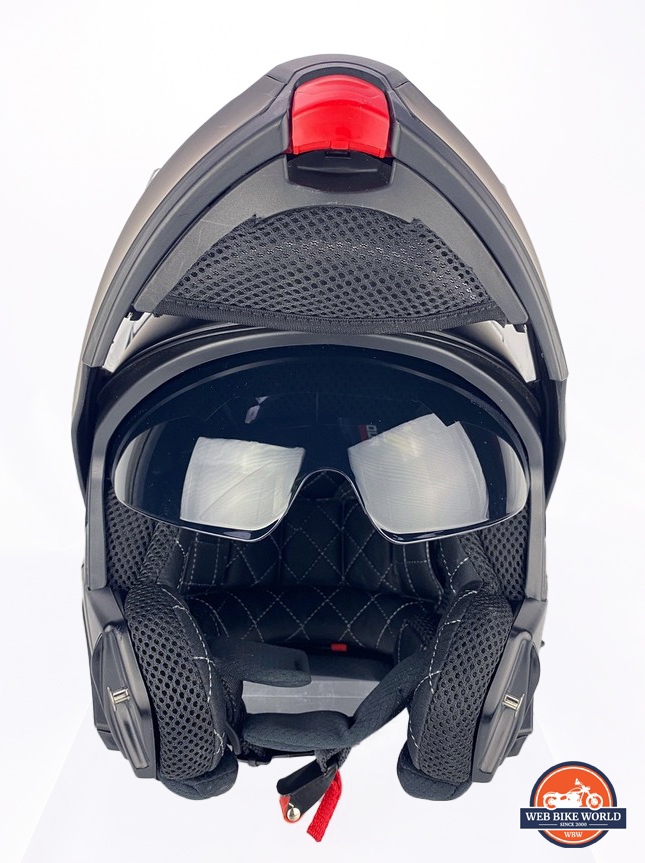
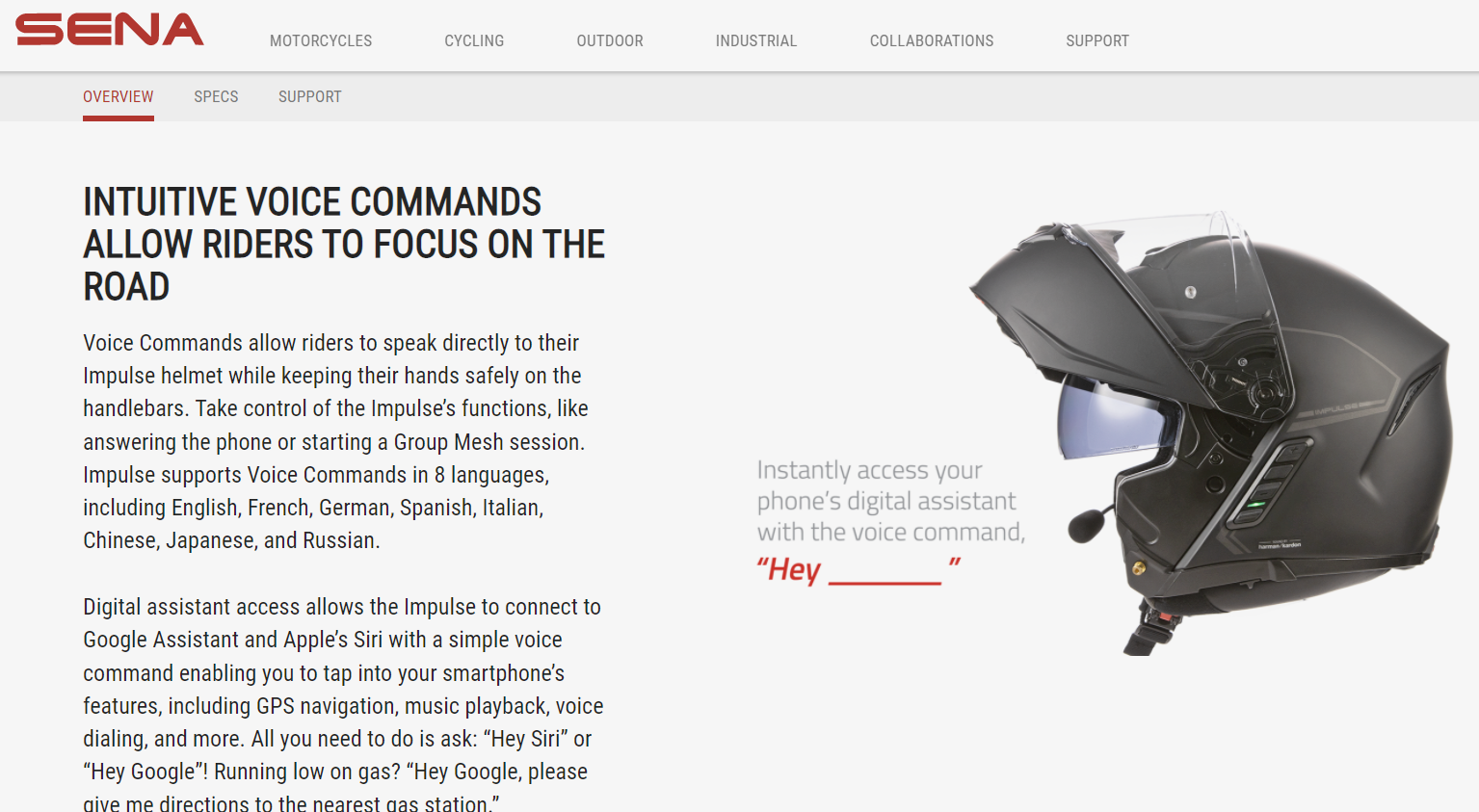
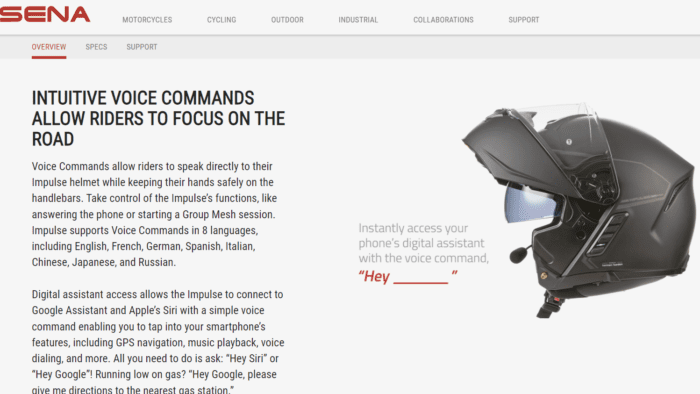
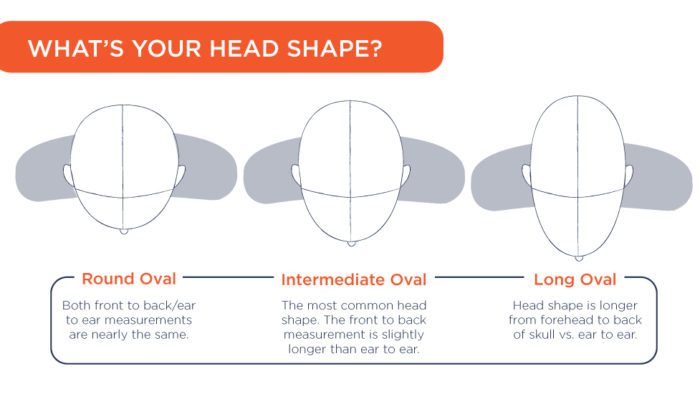




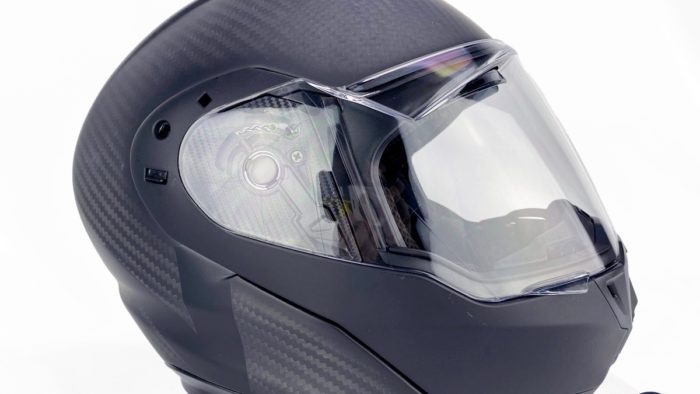
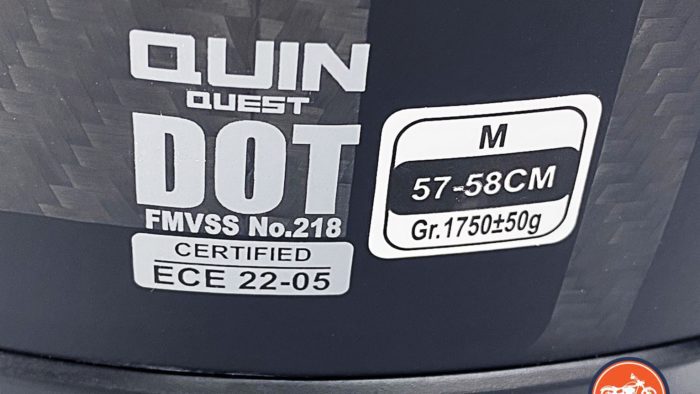

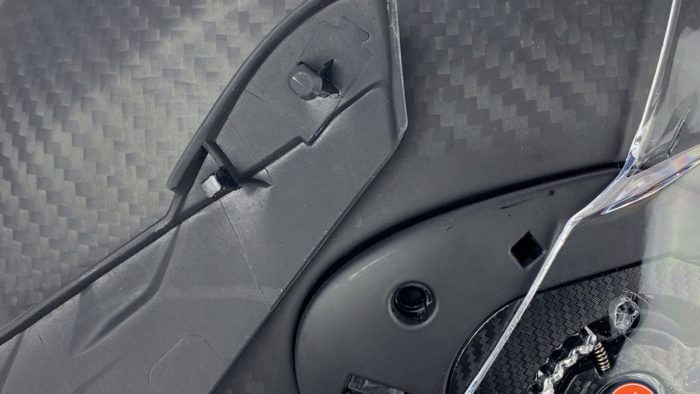


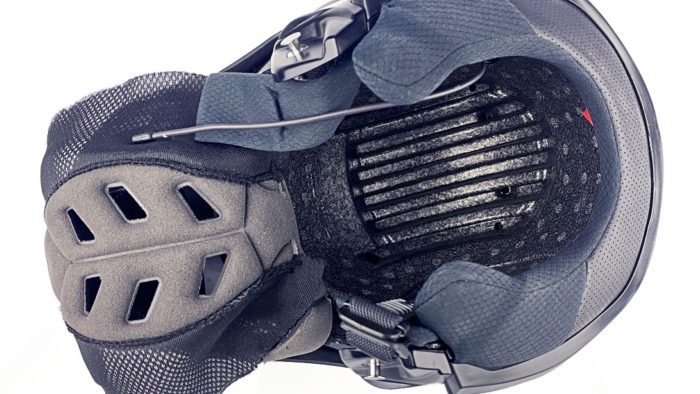
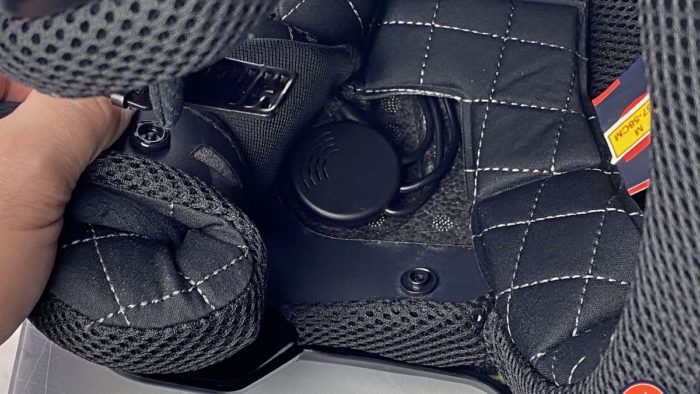
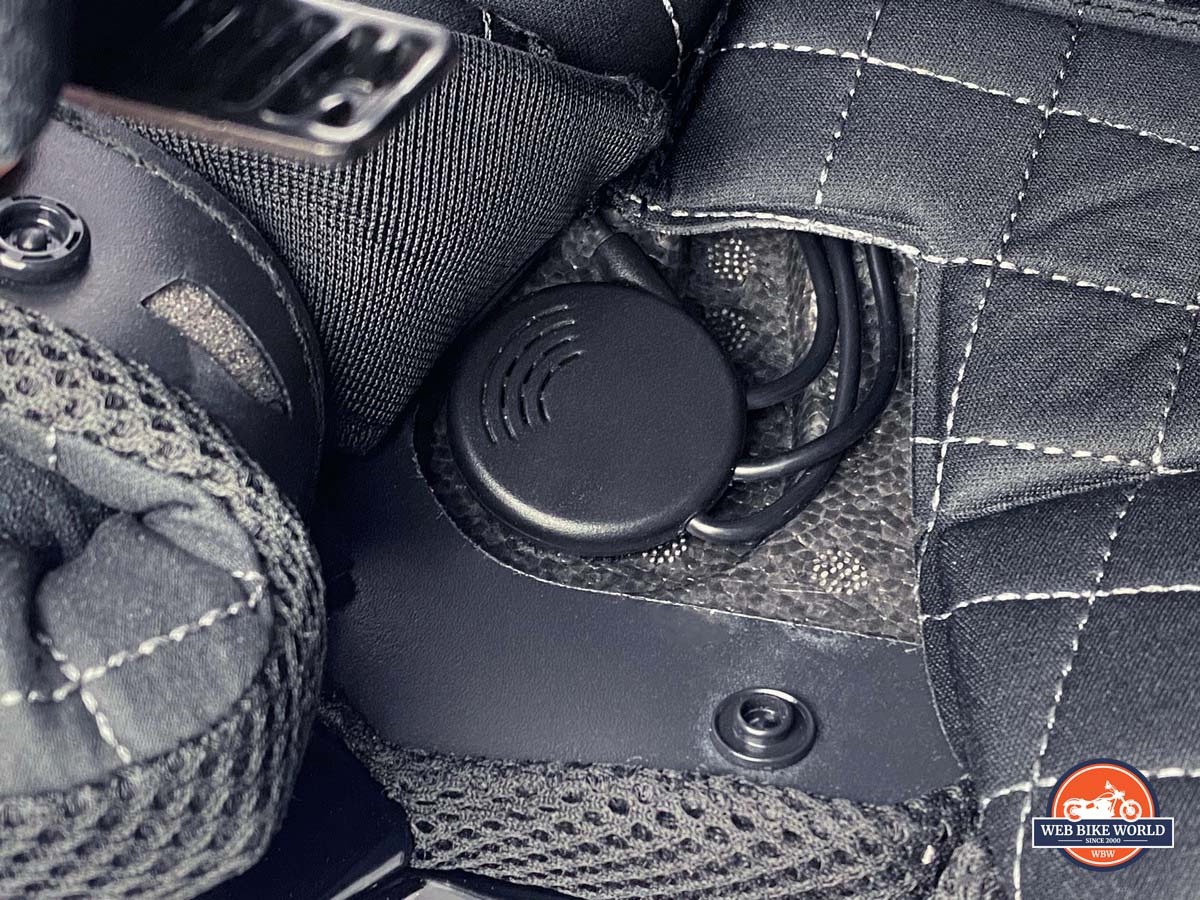
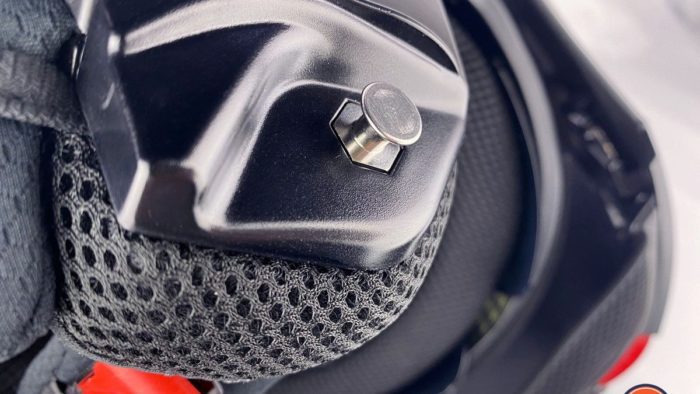
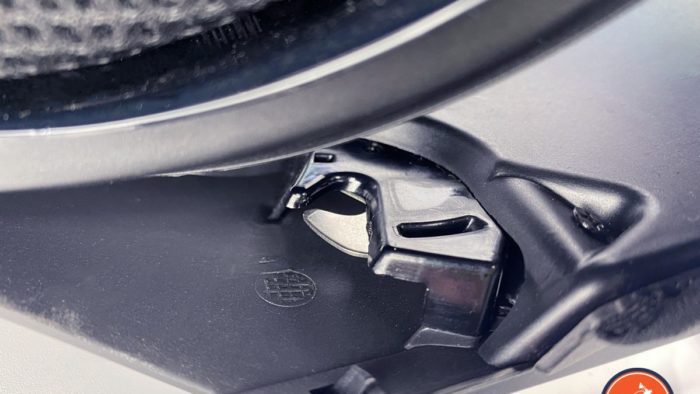


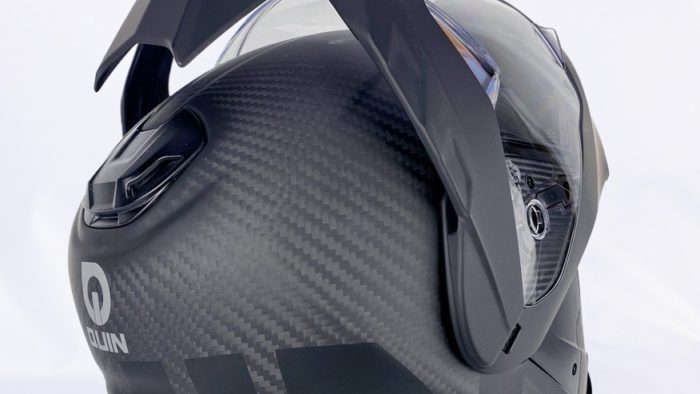

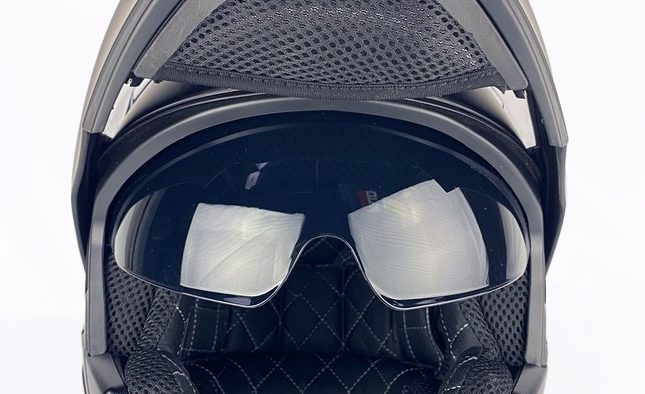
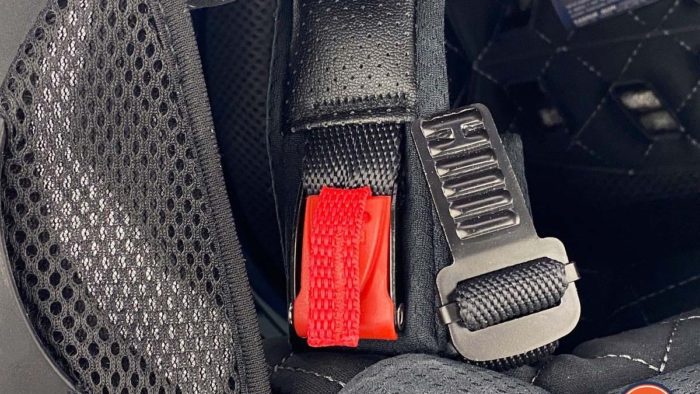


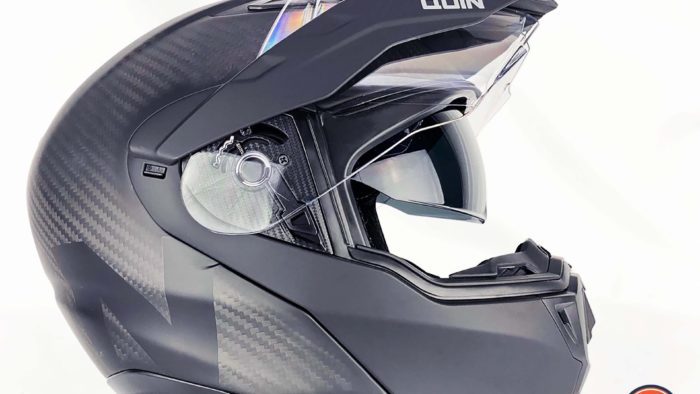

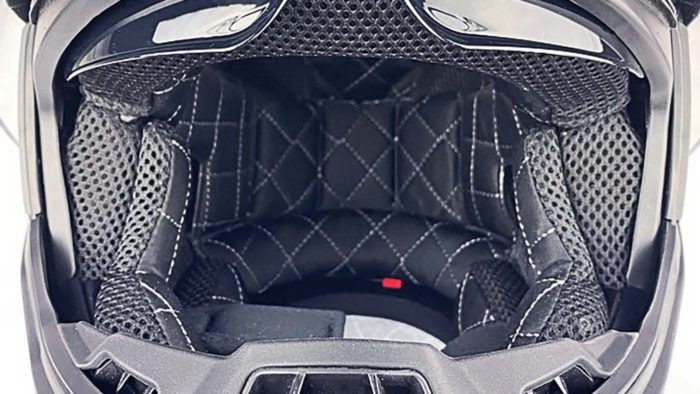
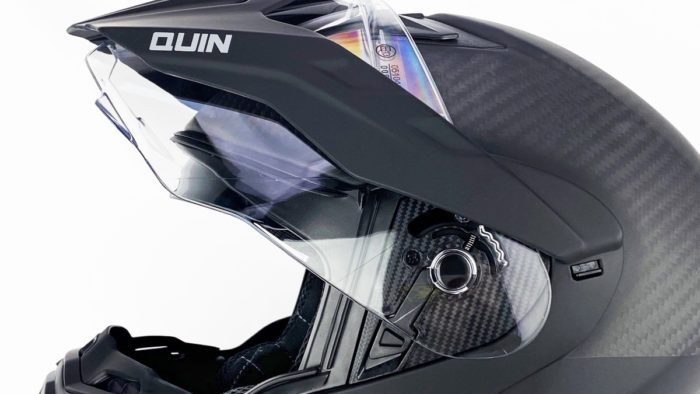


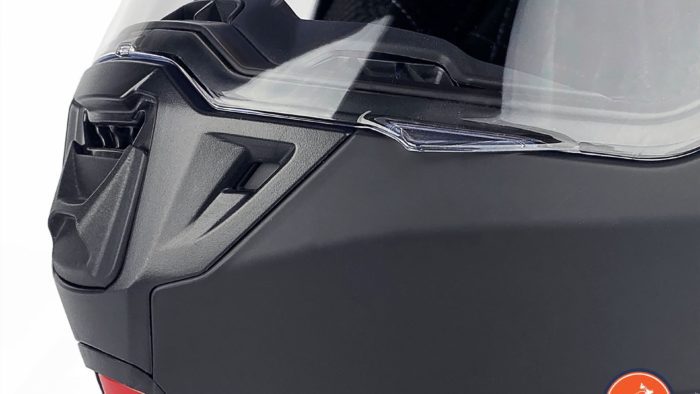

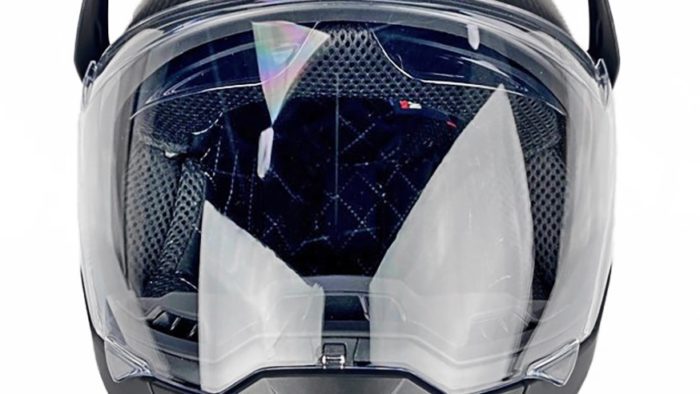
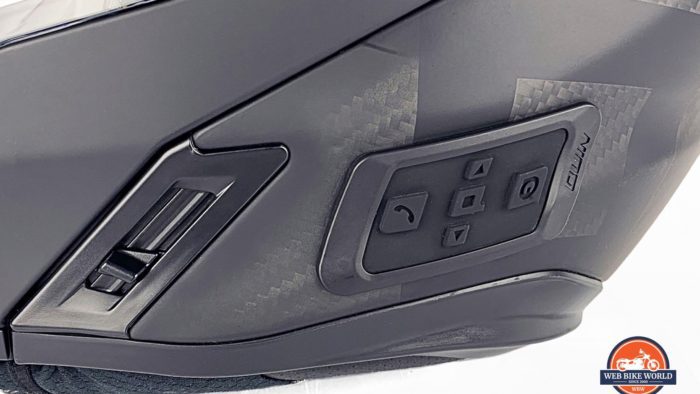
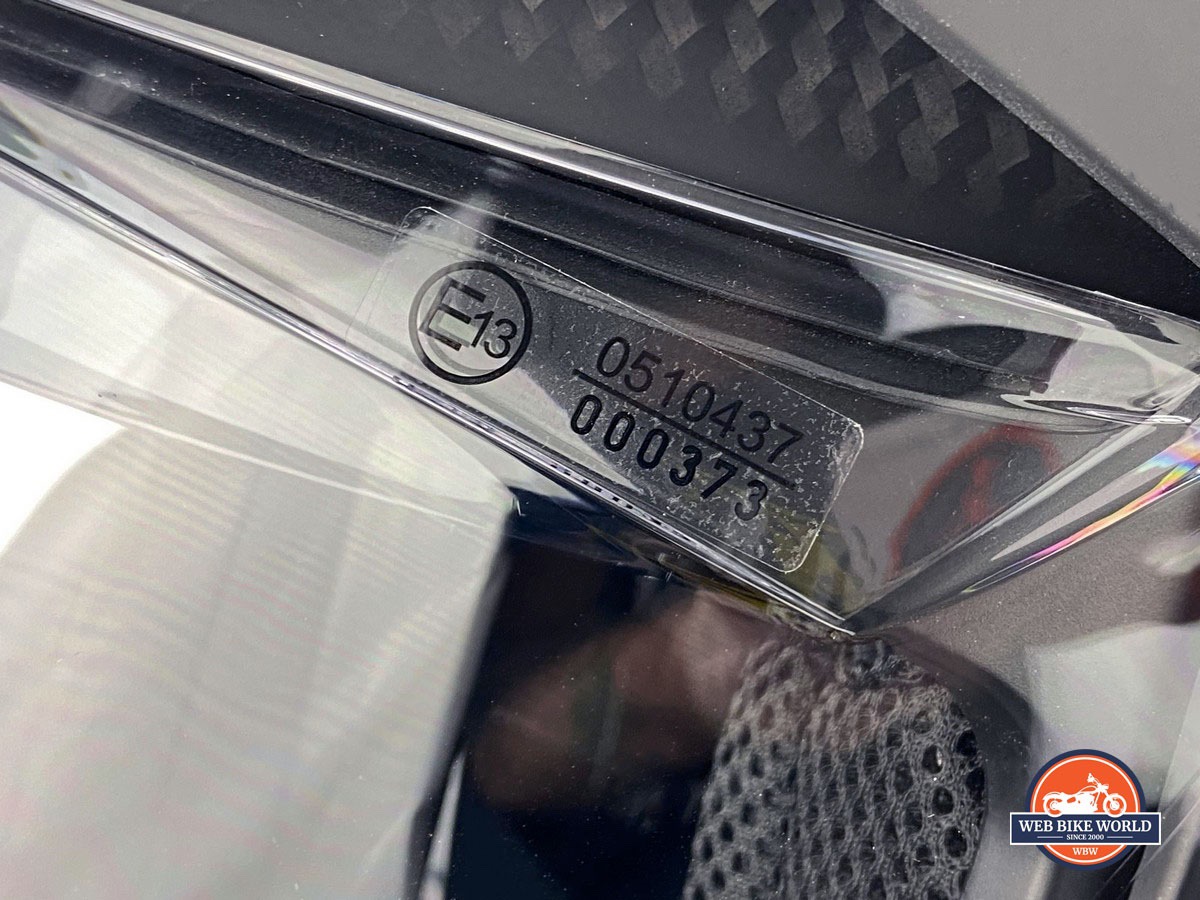
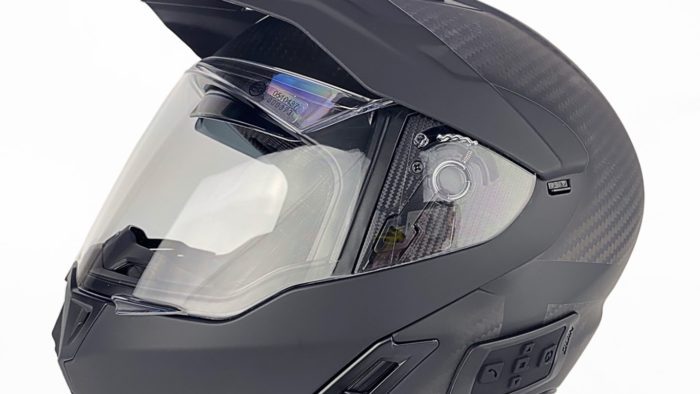
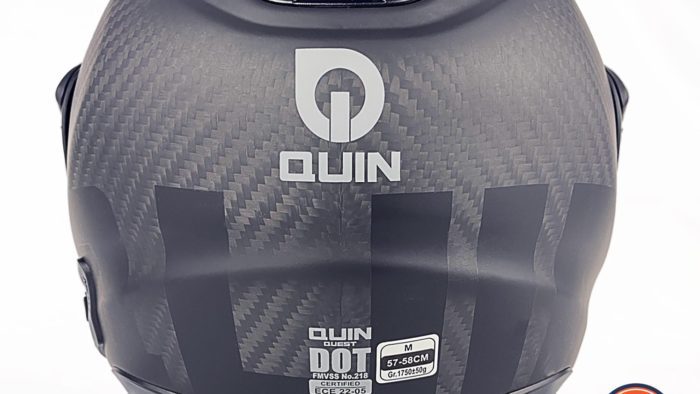
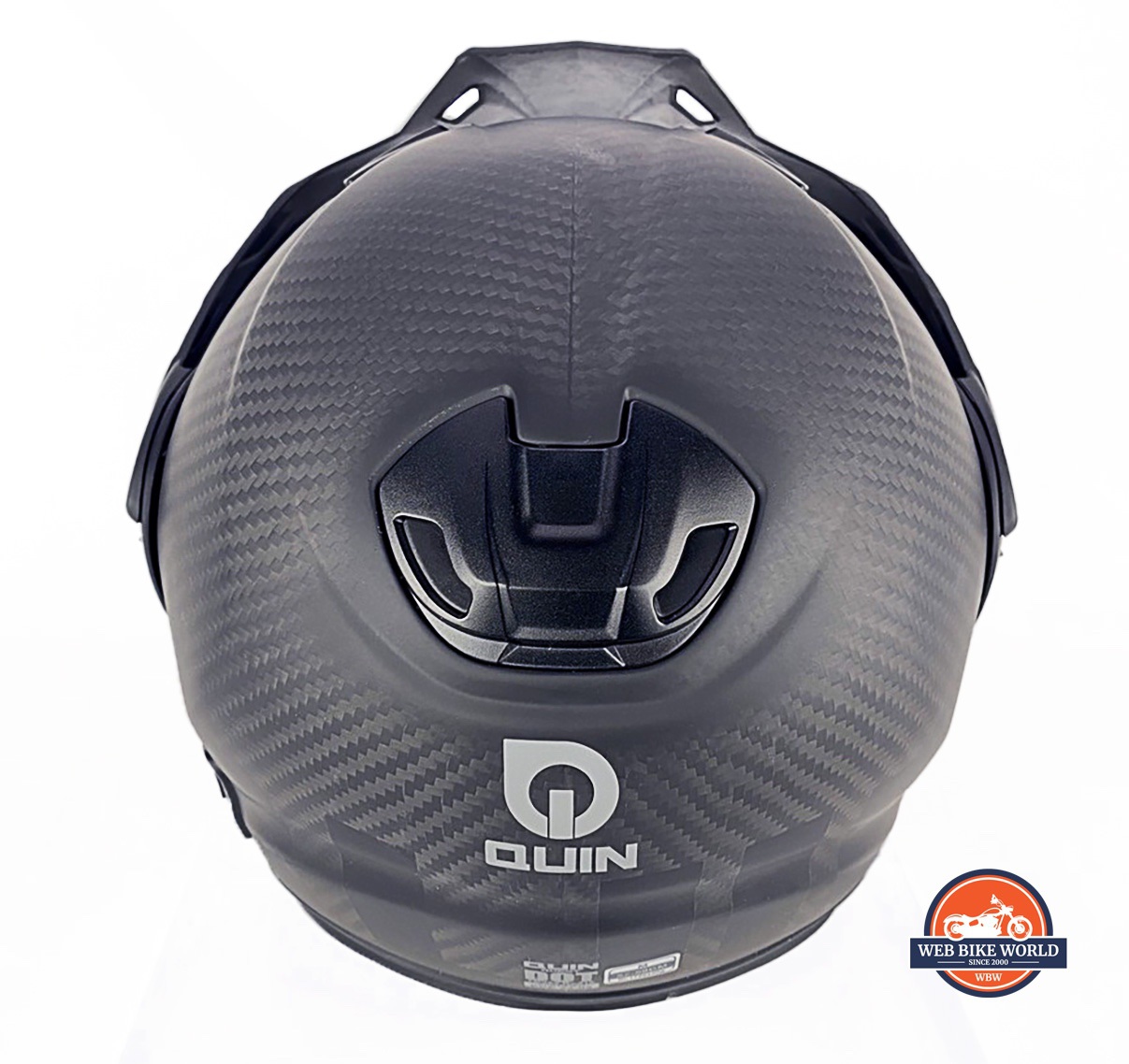
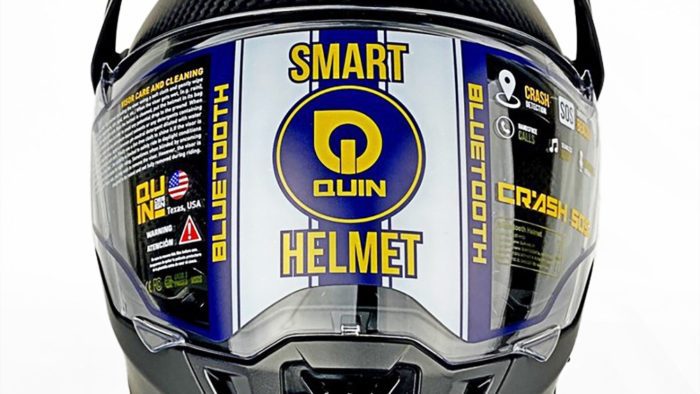
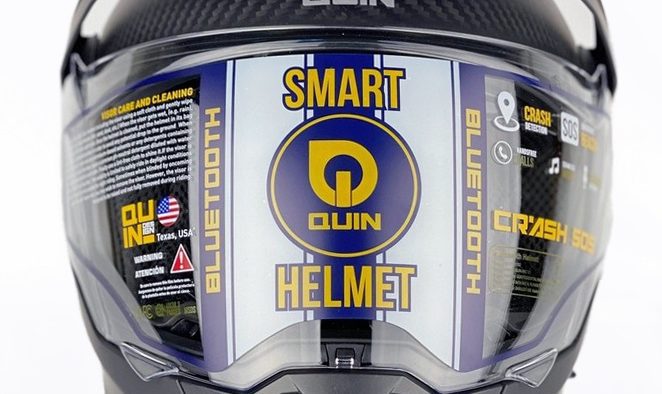

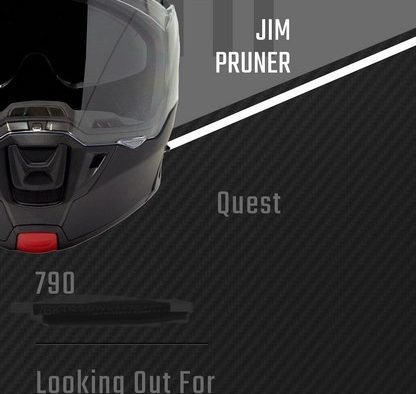


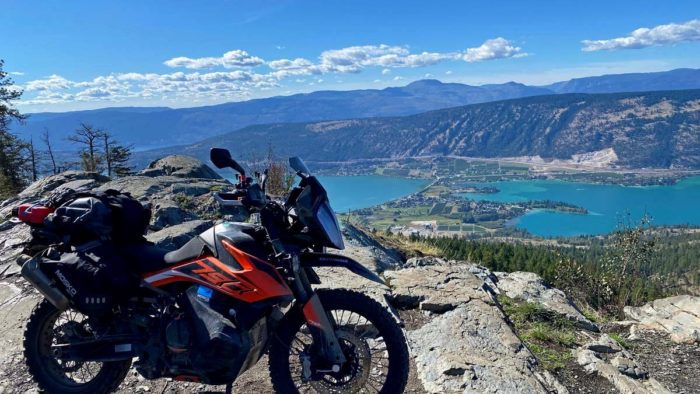



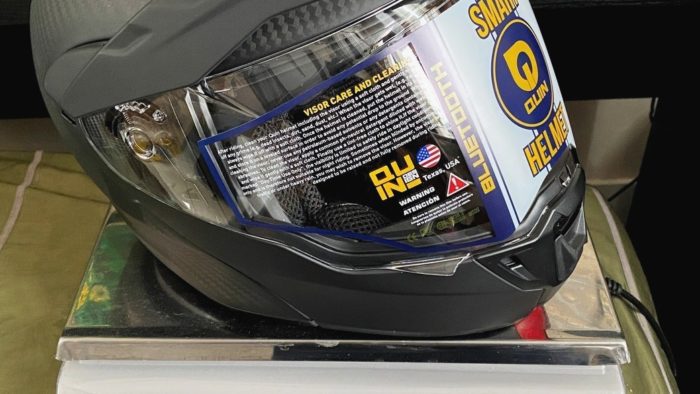


No Comment